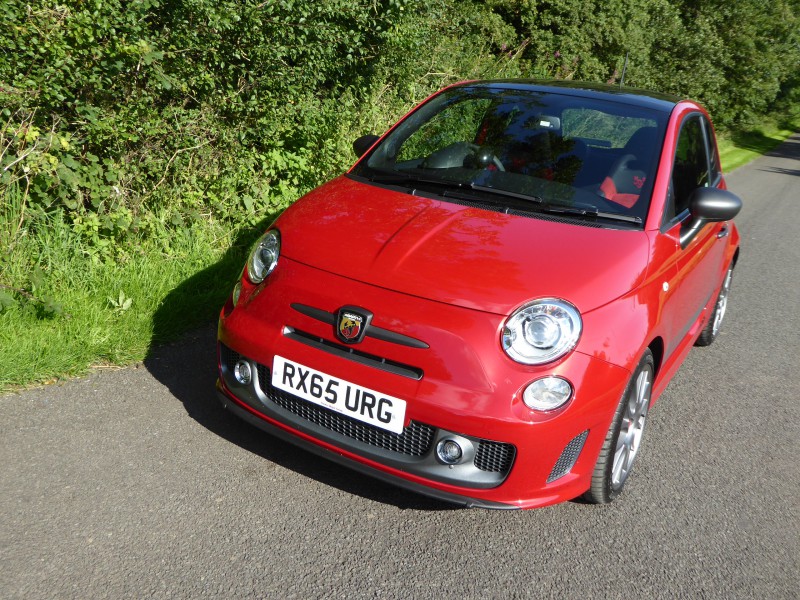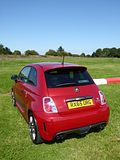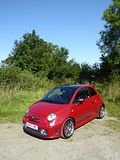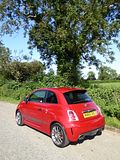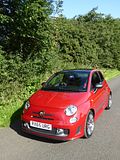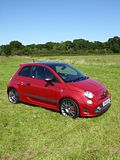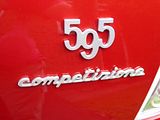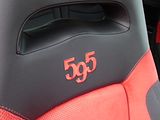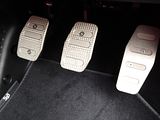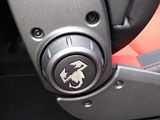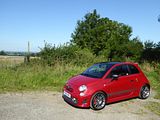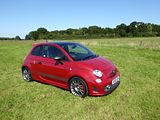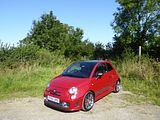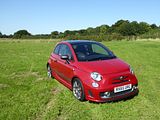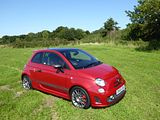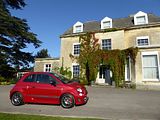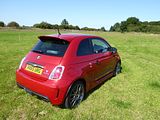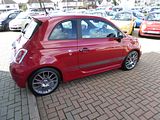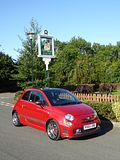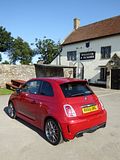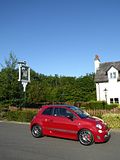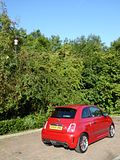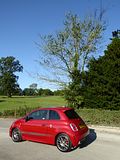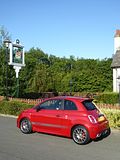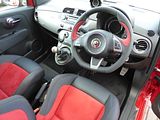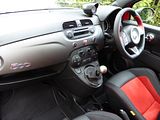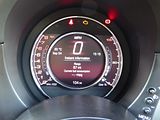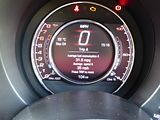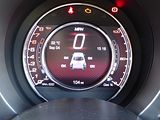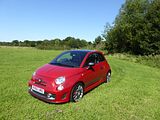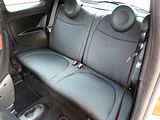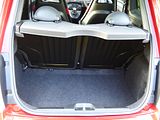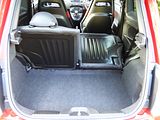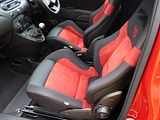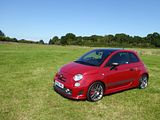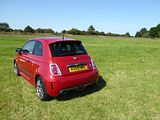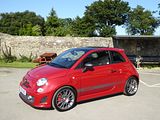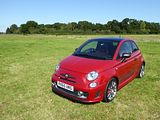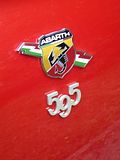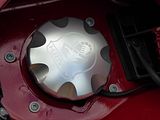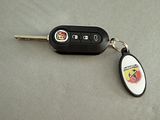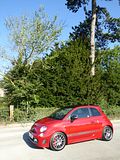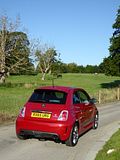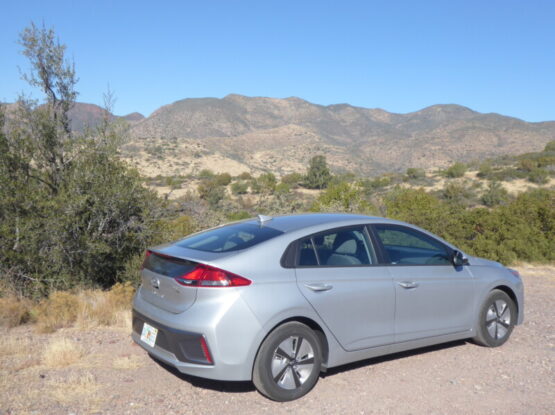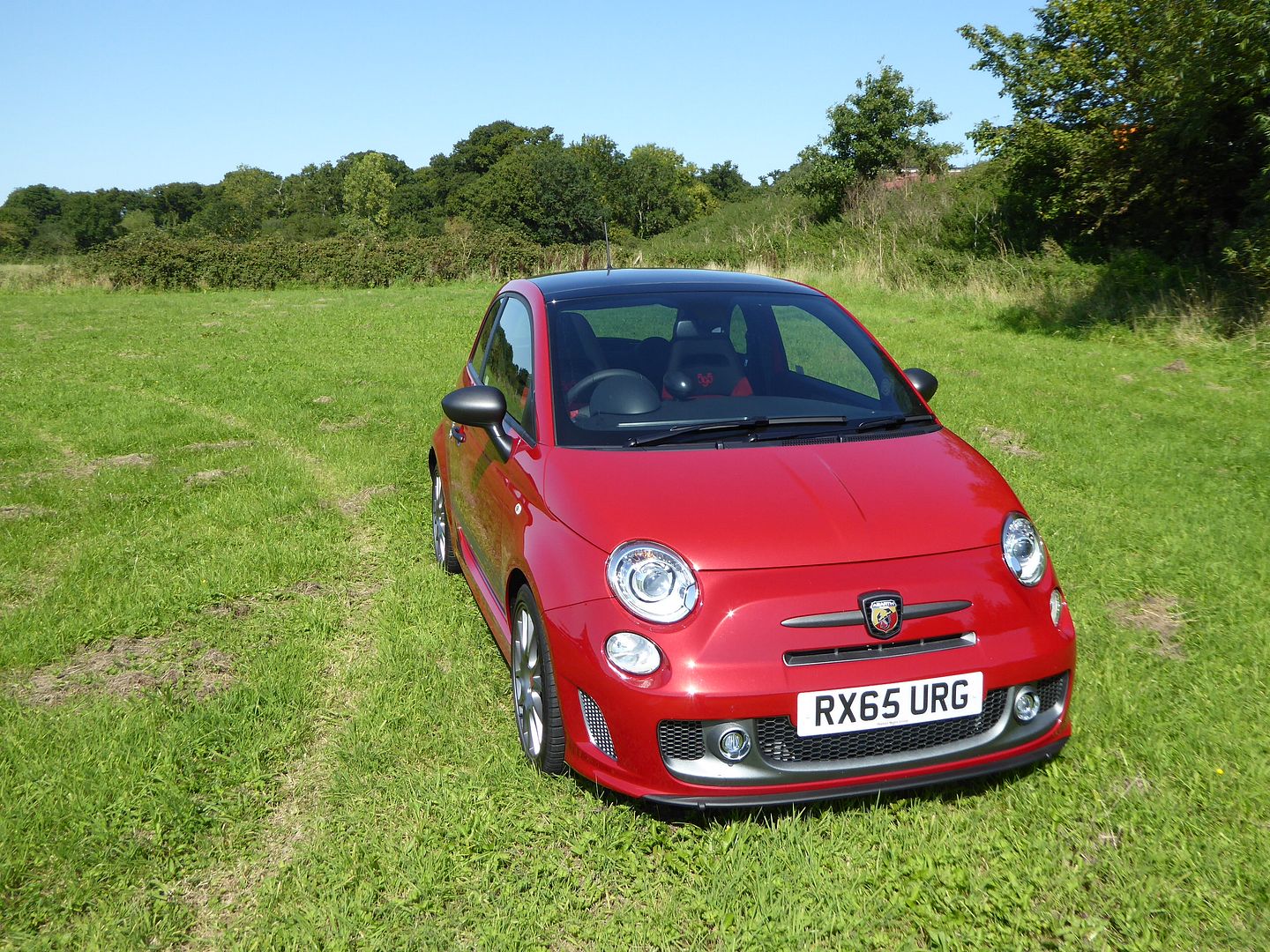
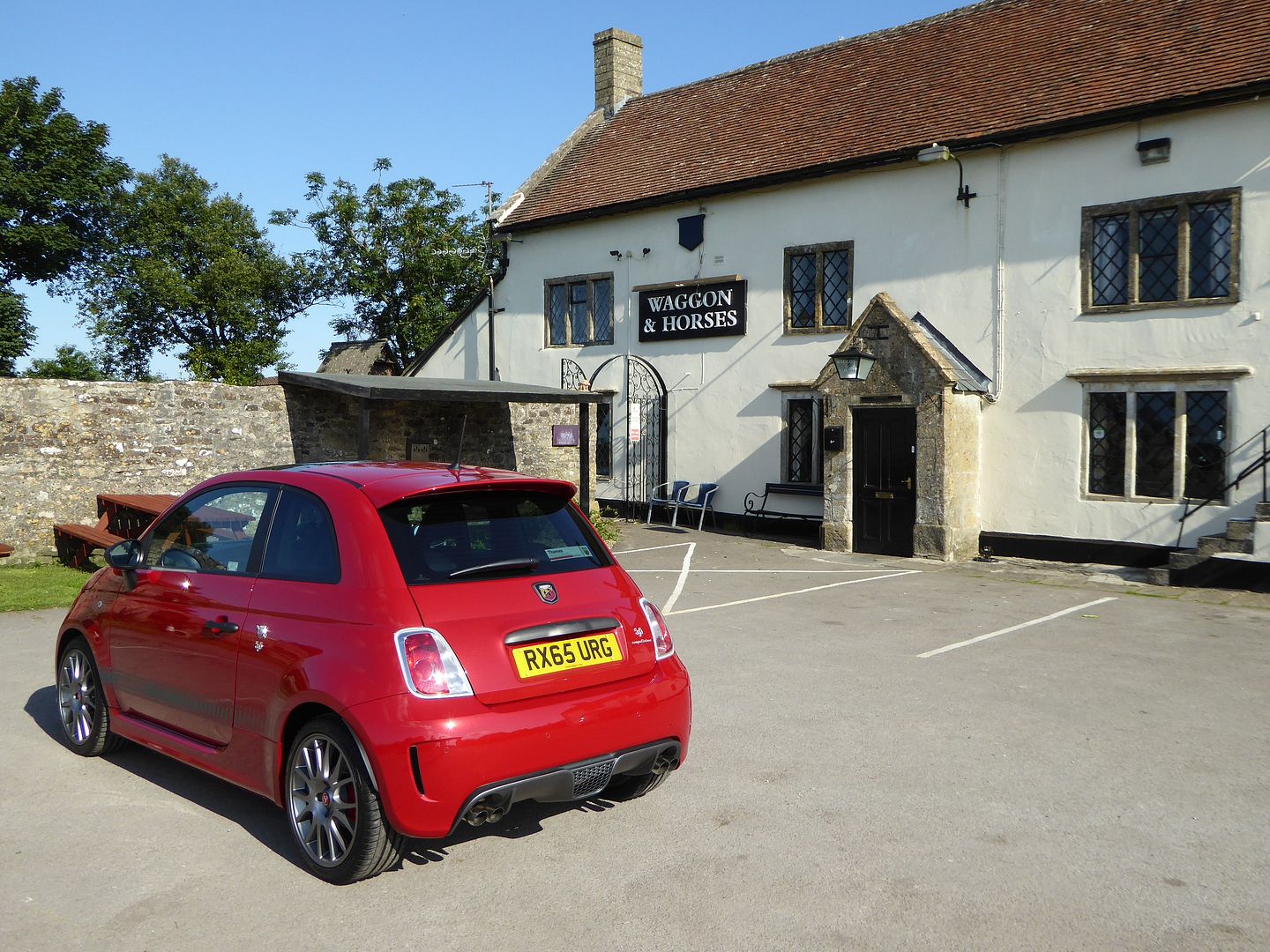
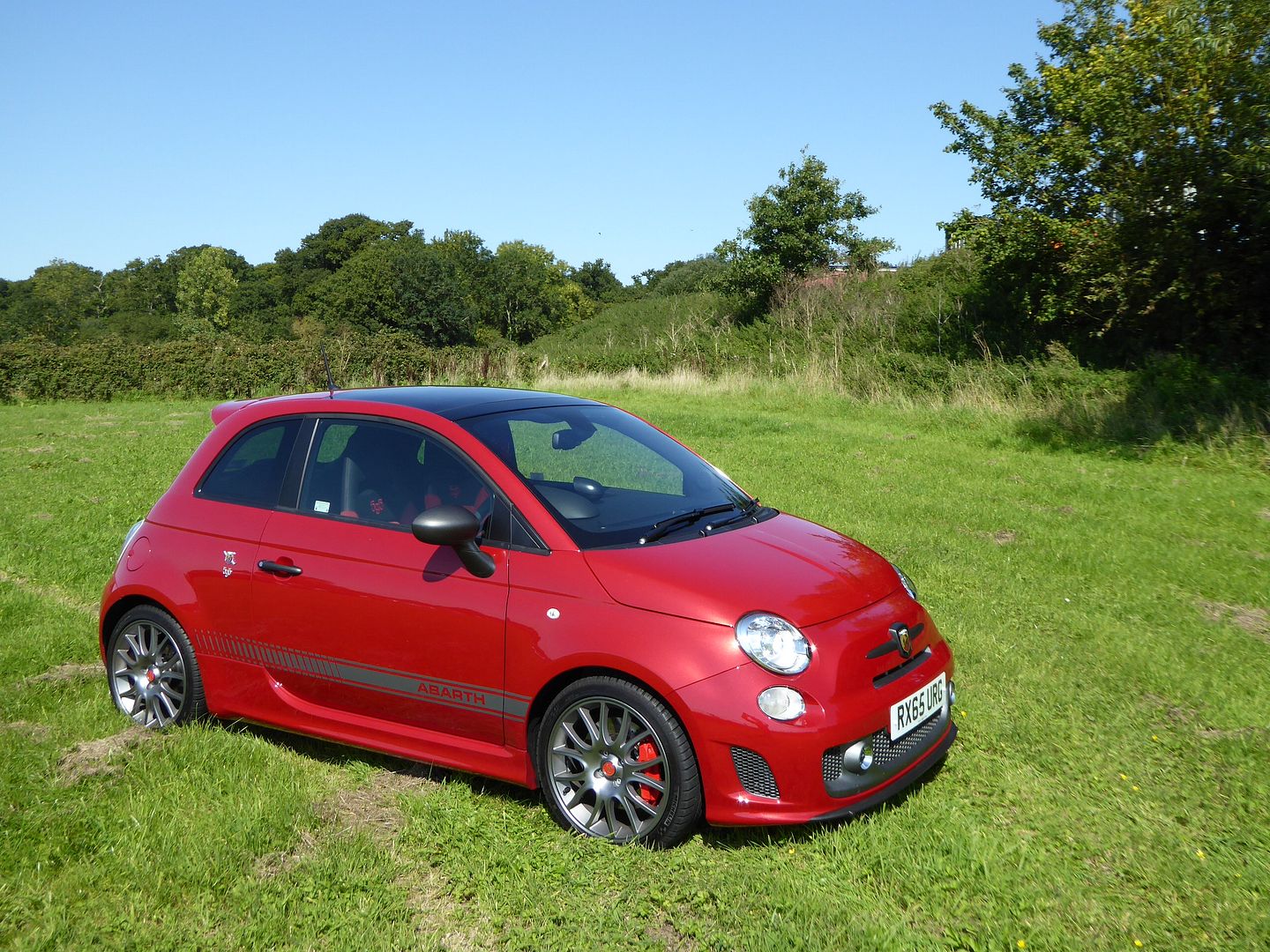
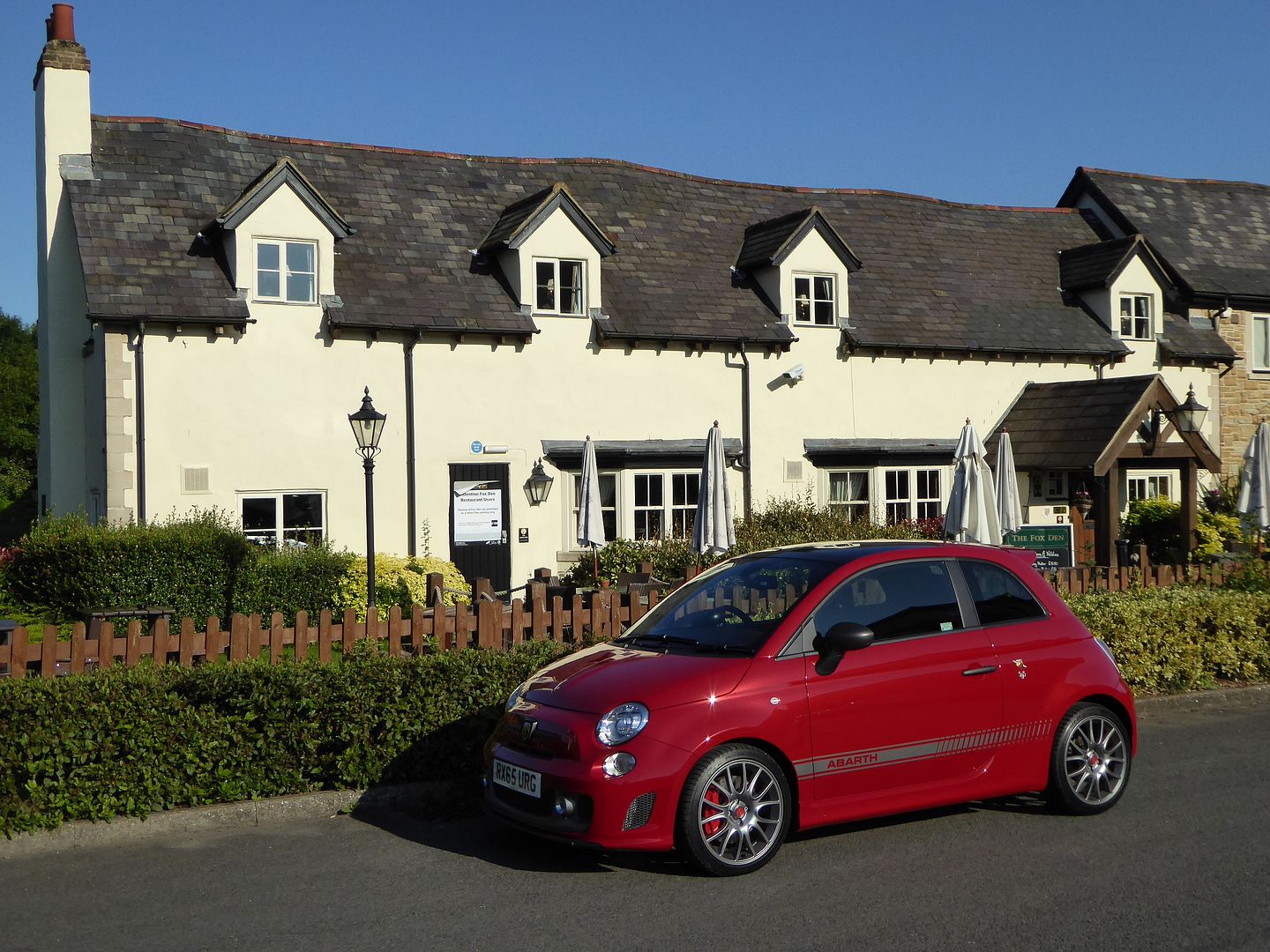

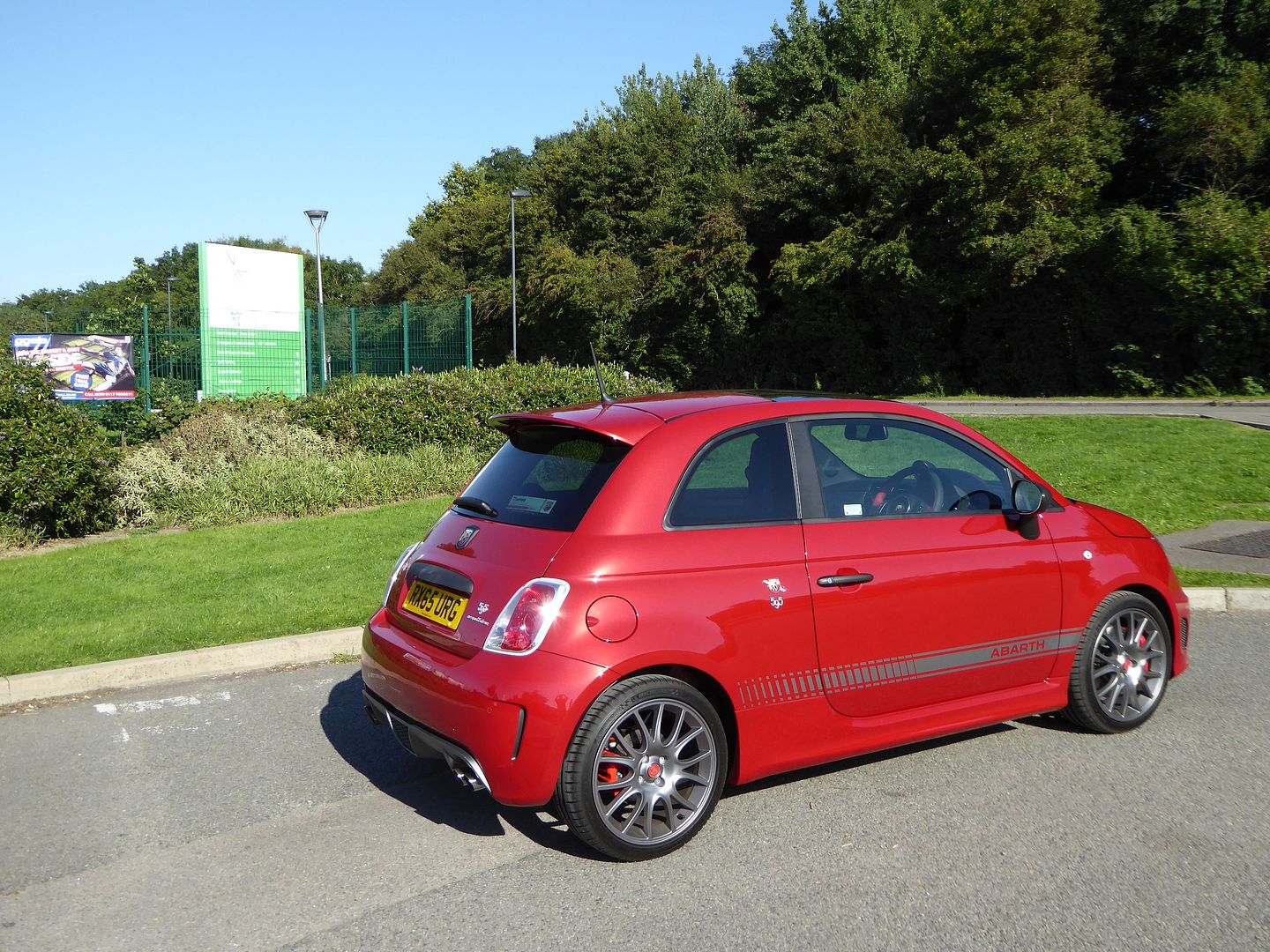
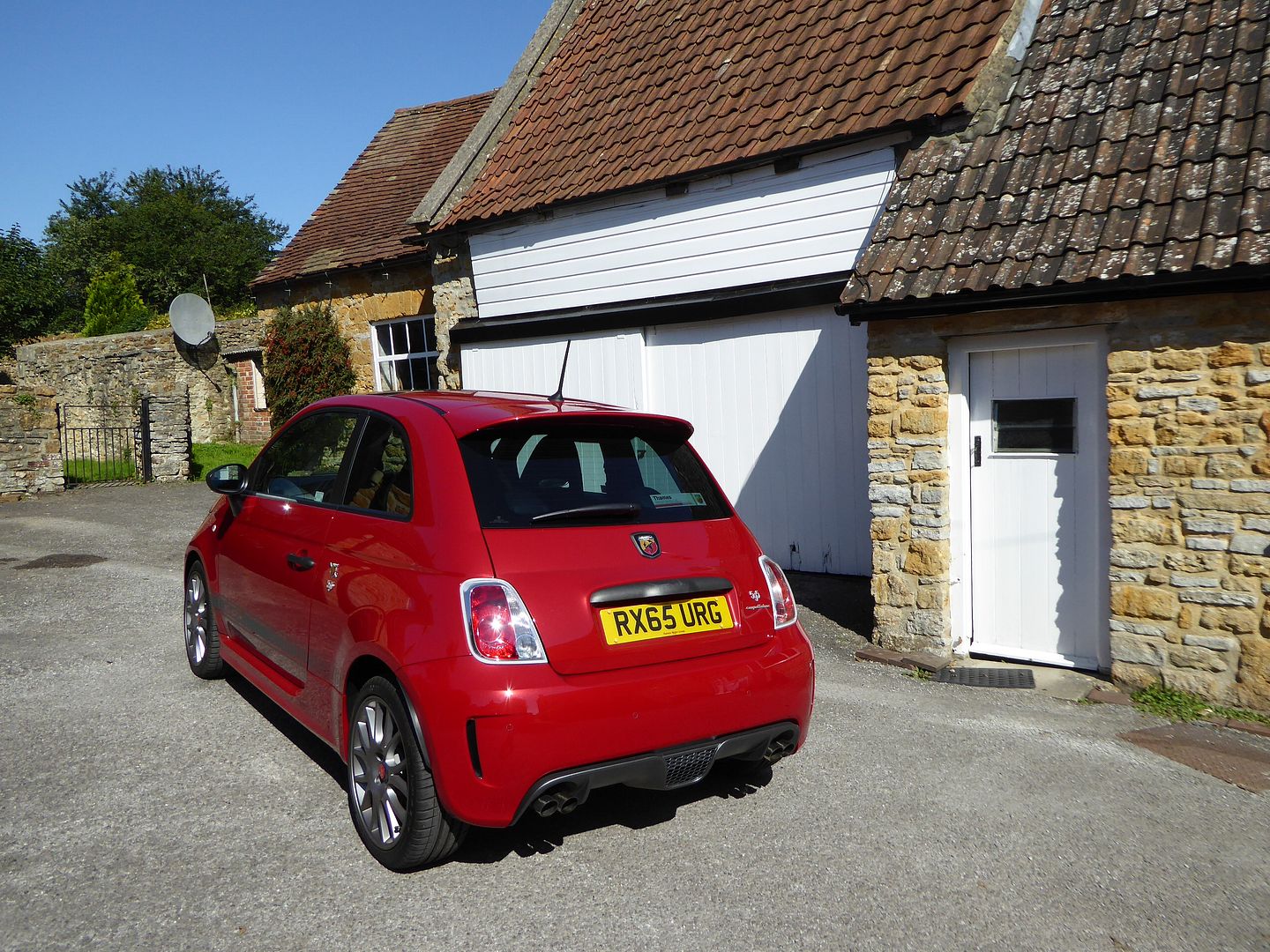
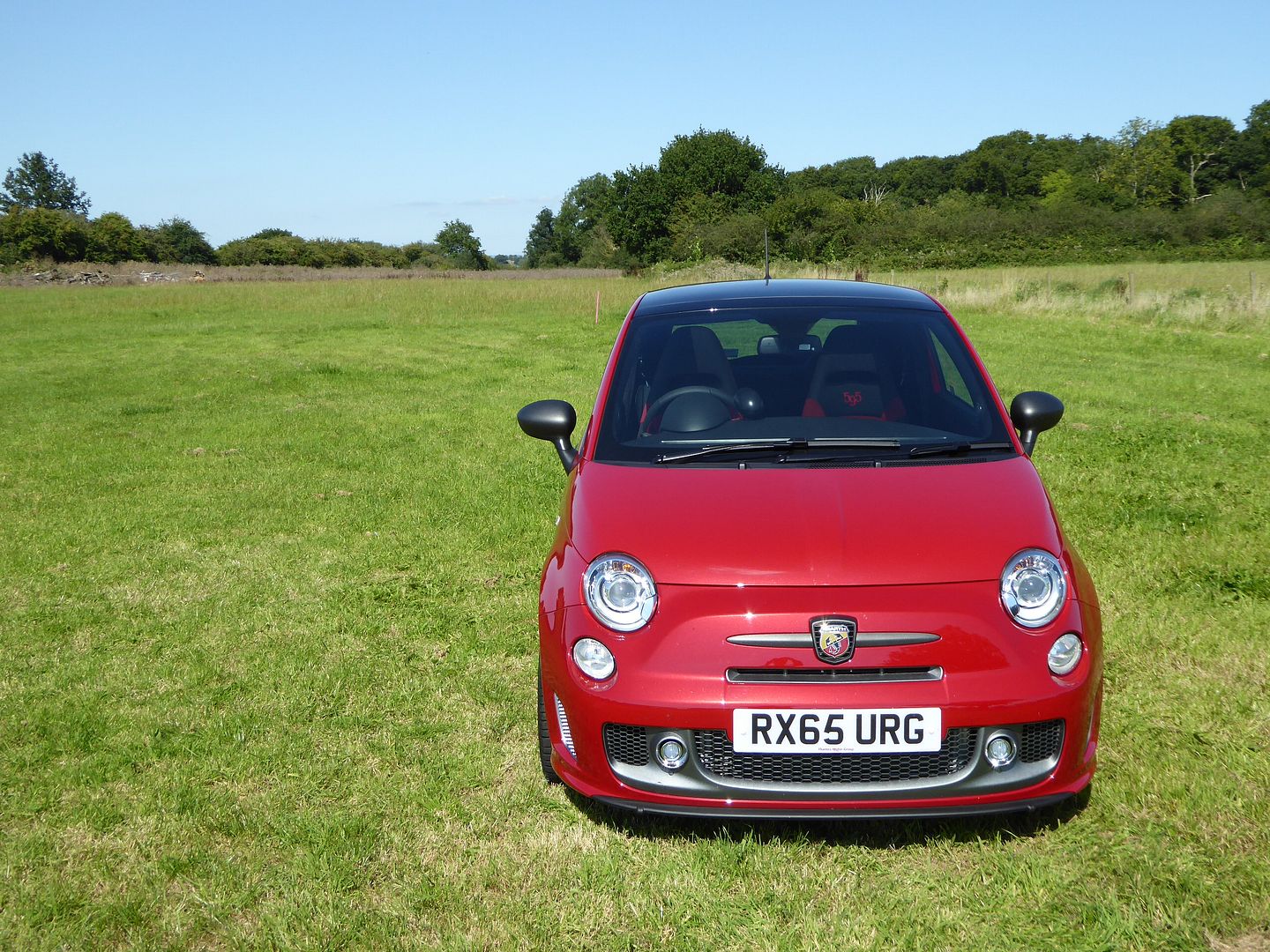


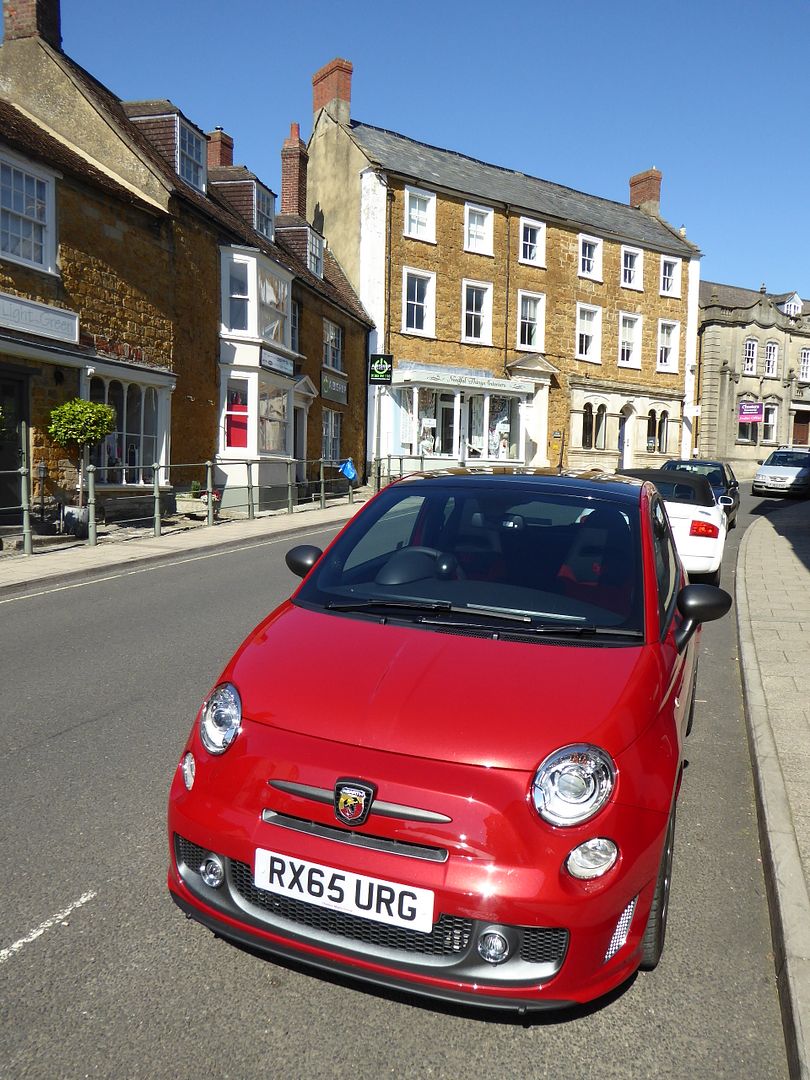
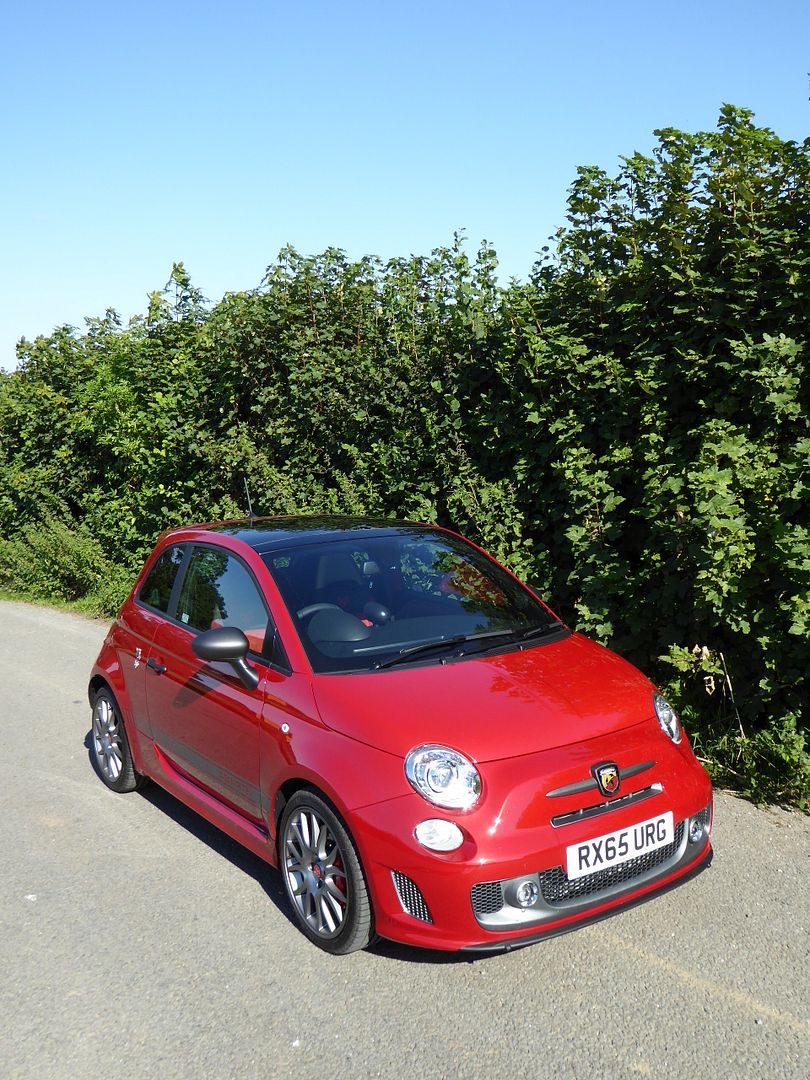
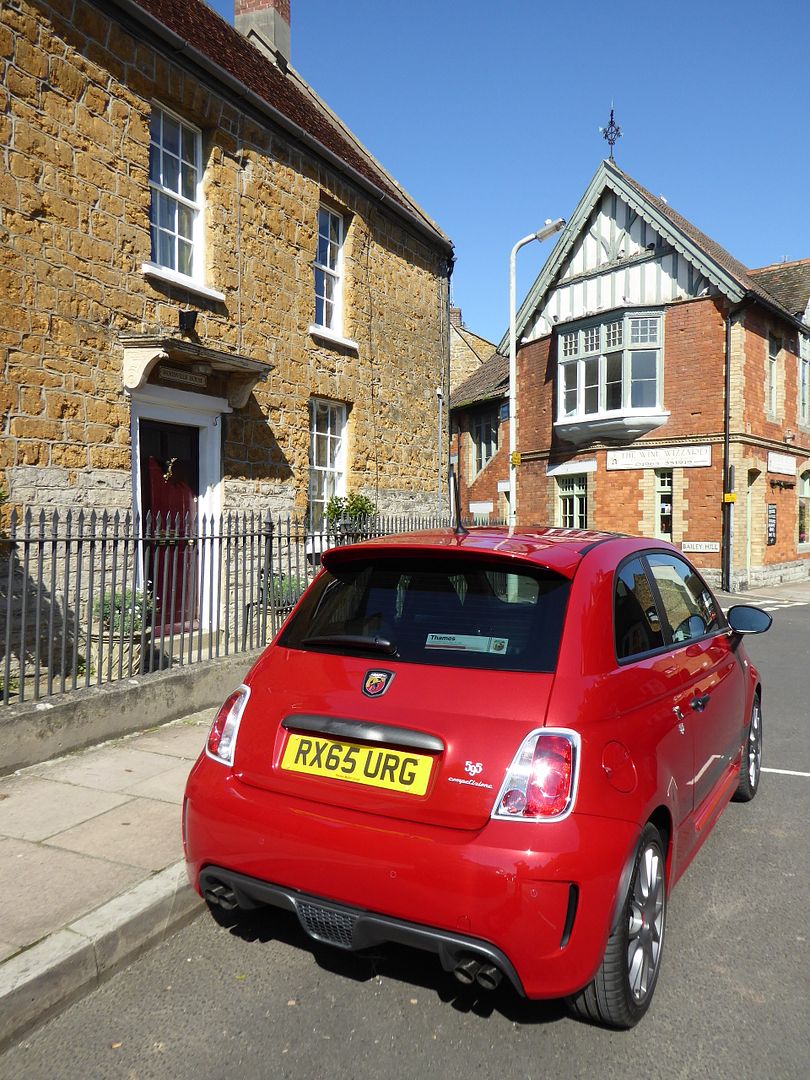
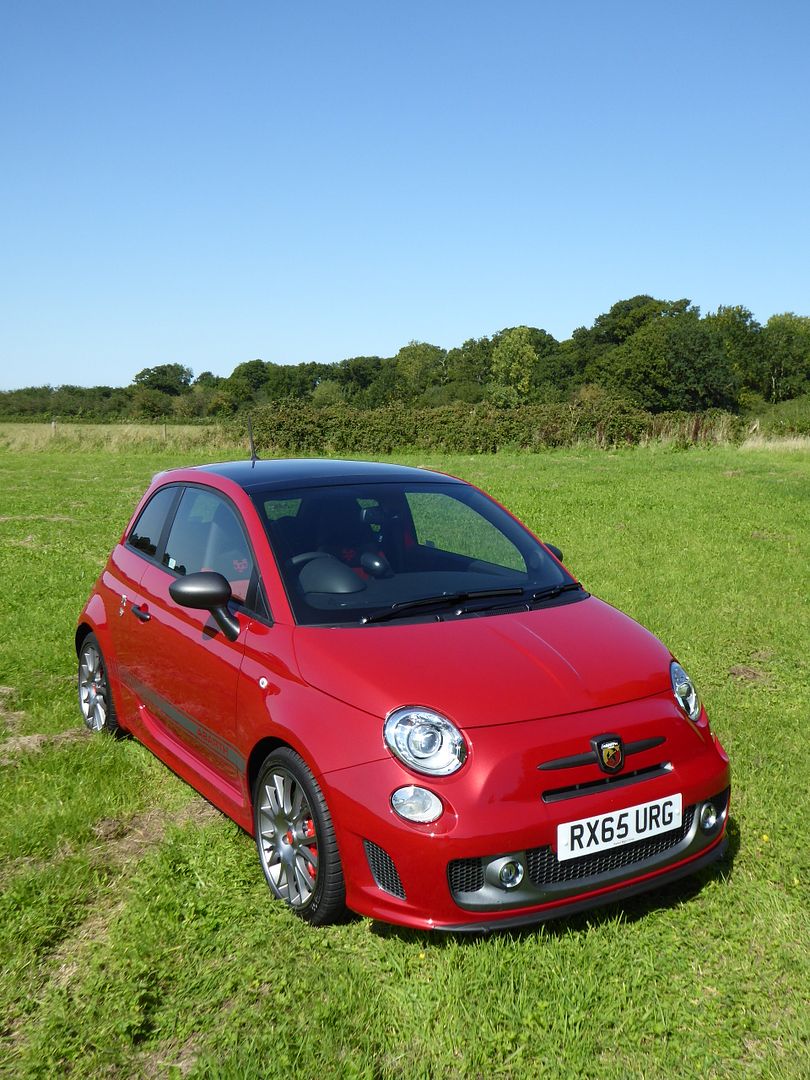
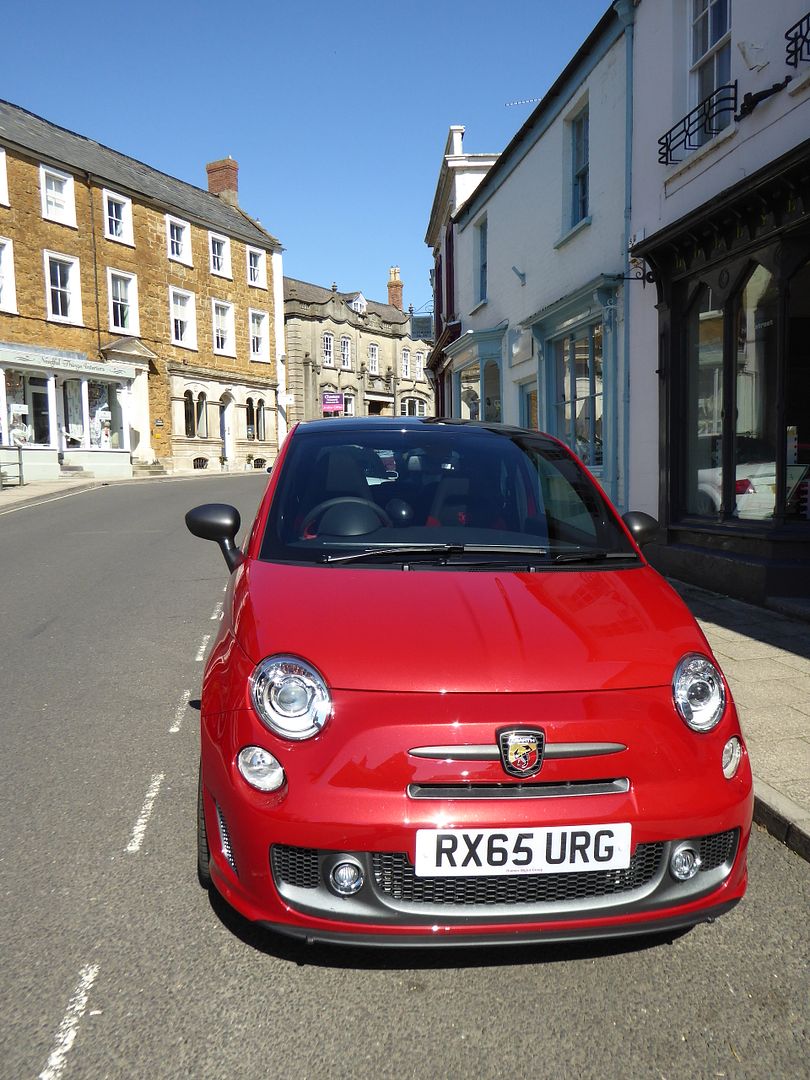
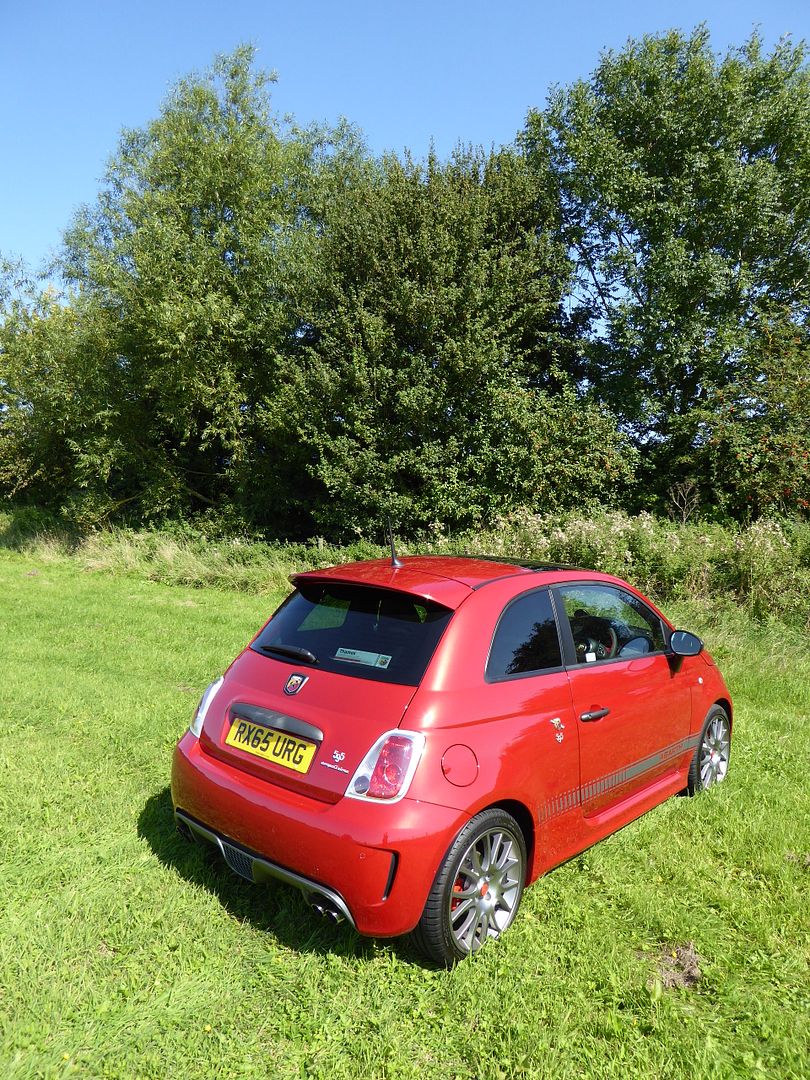
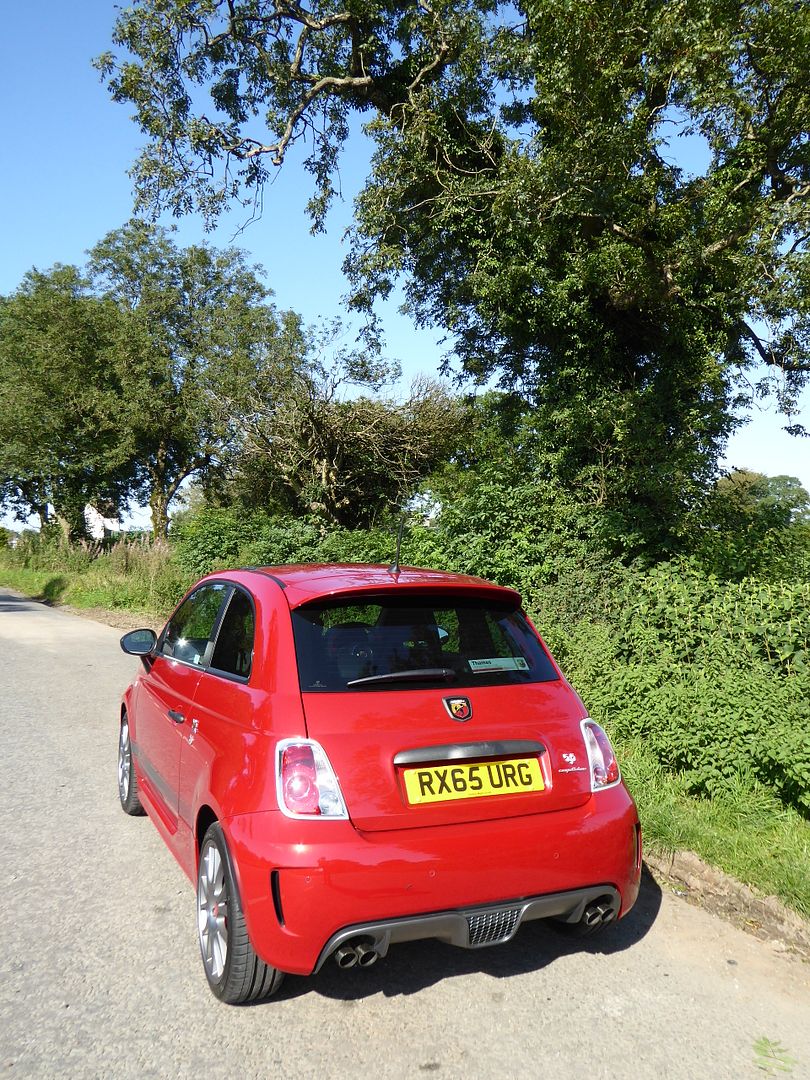
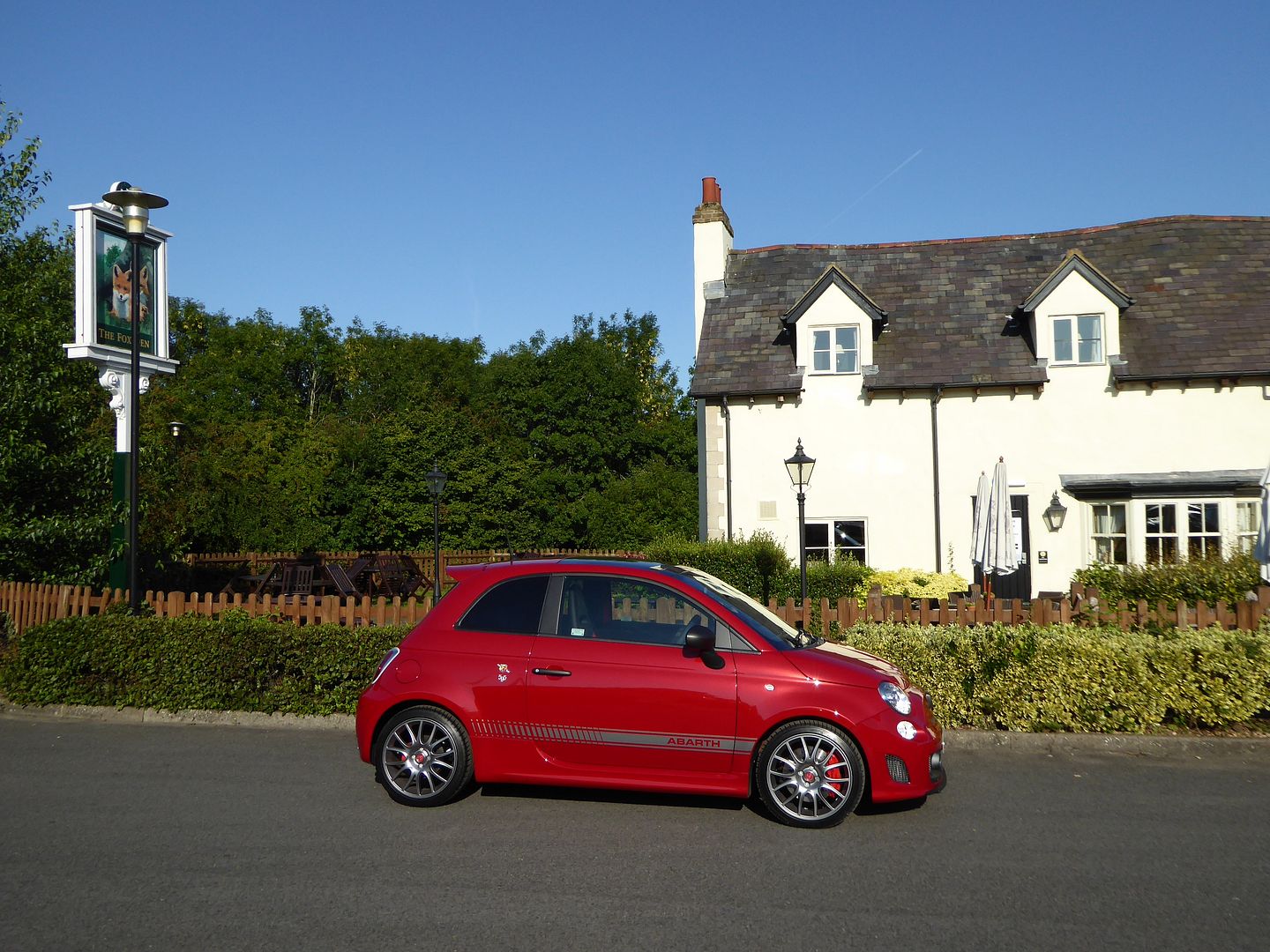
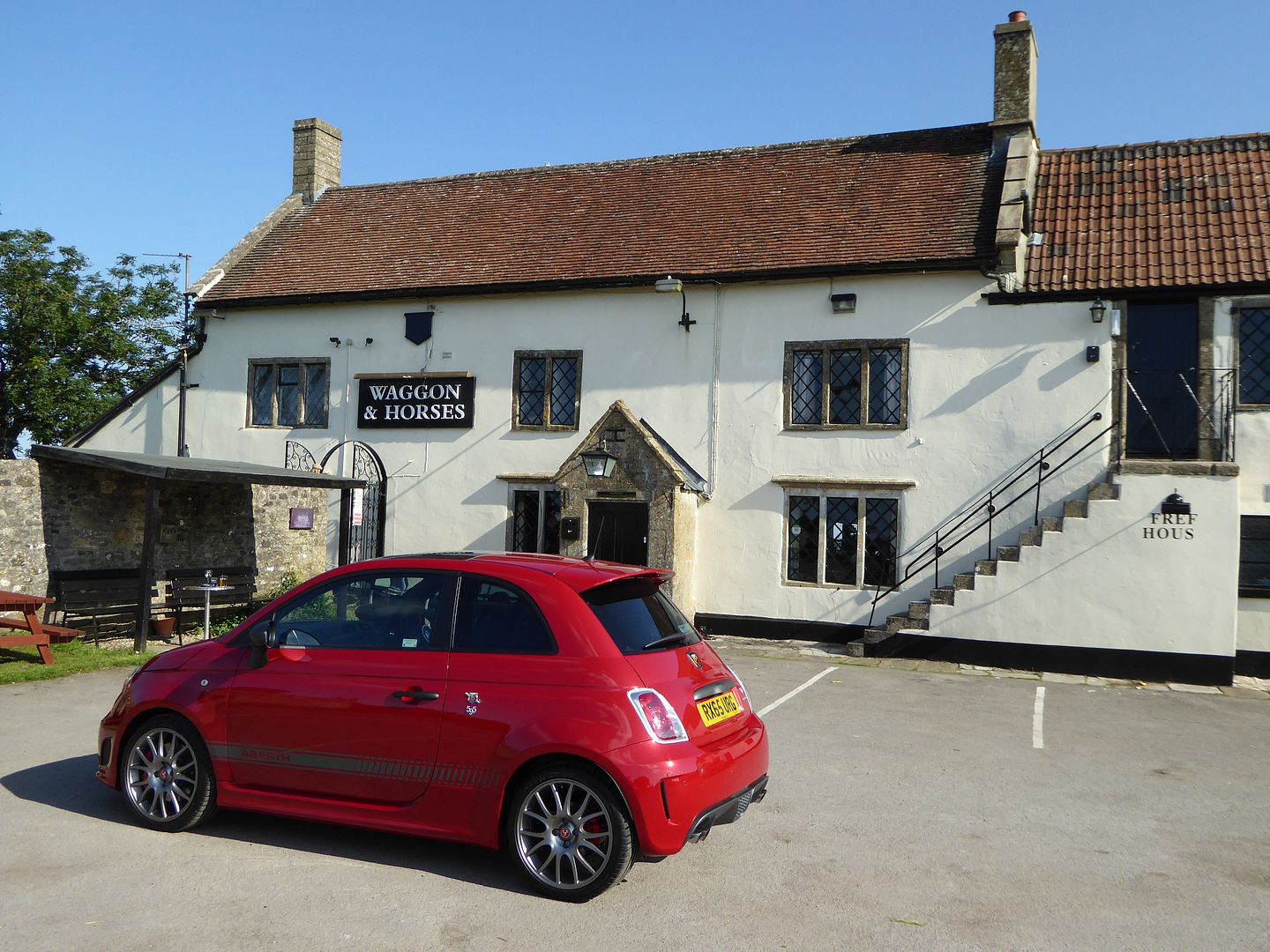
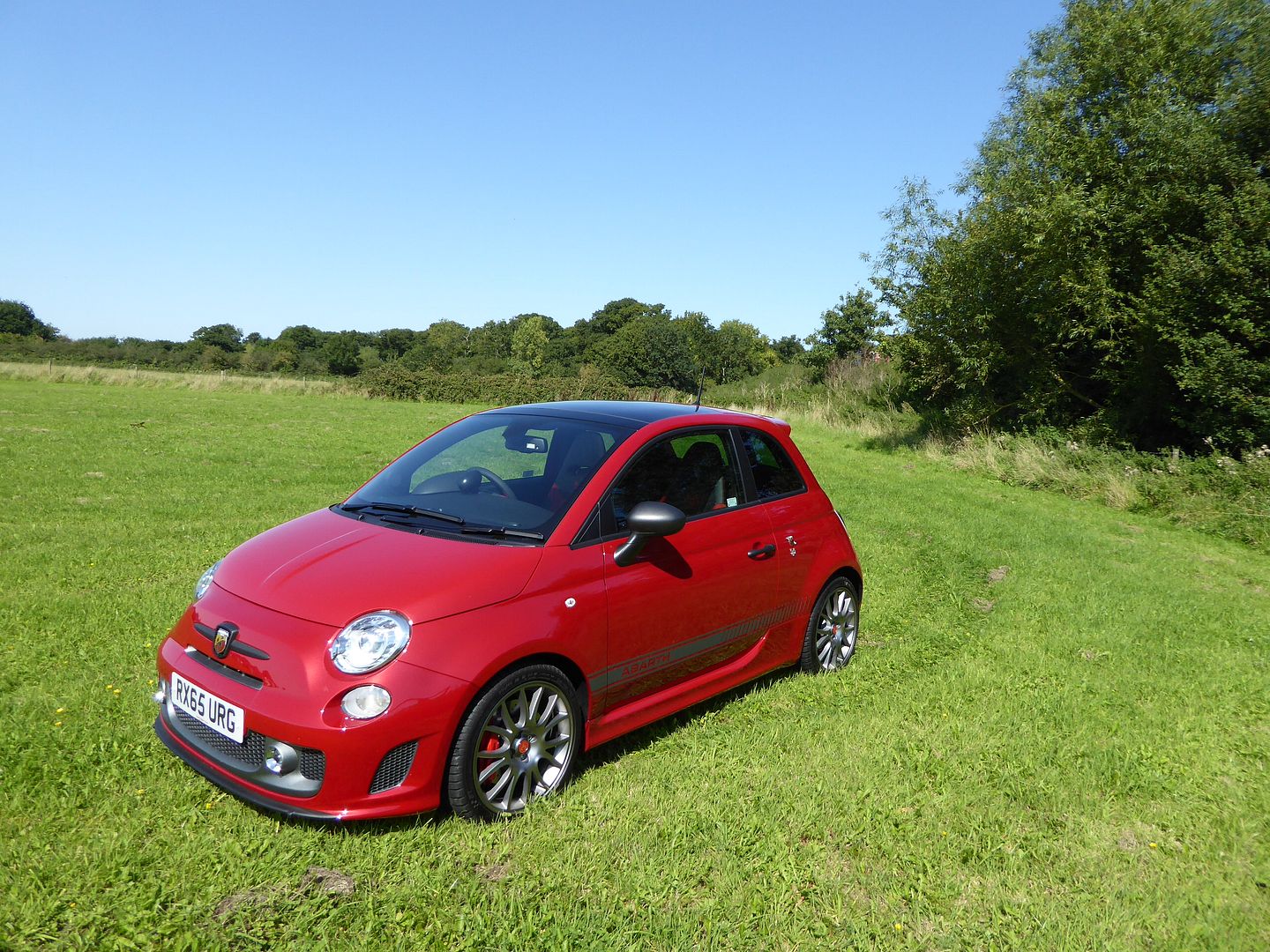
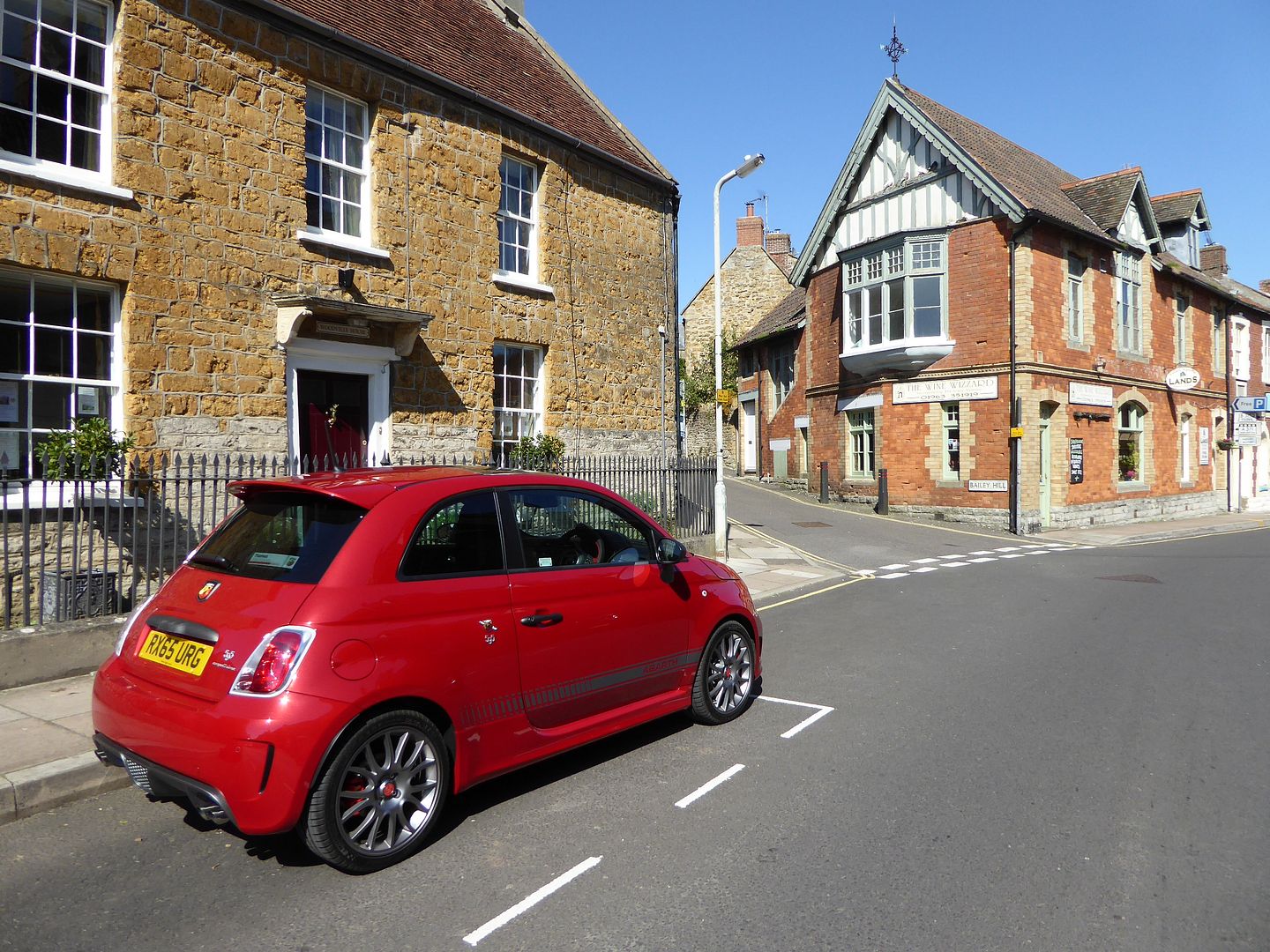
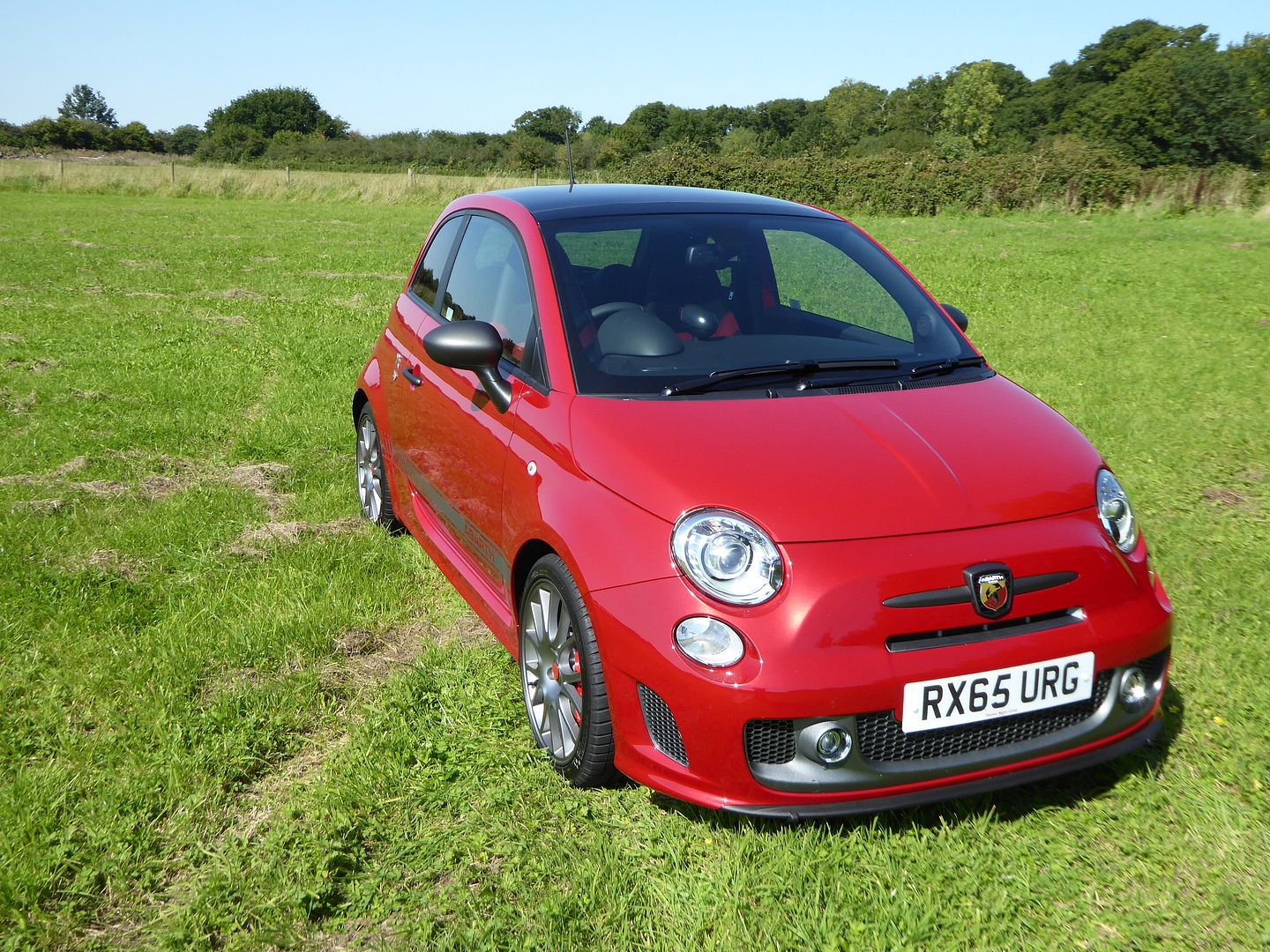
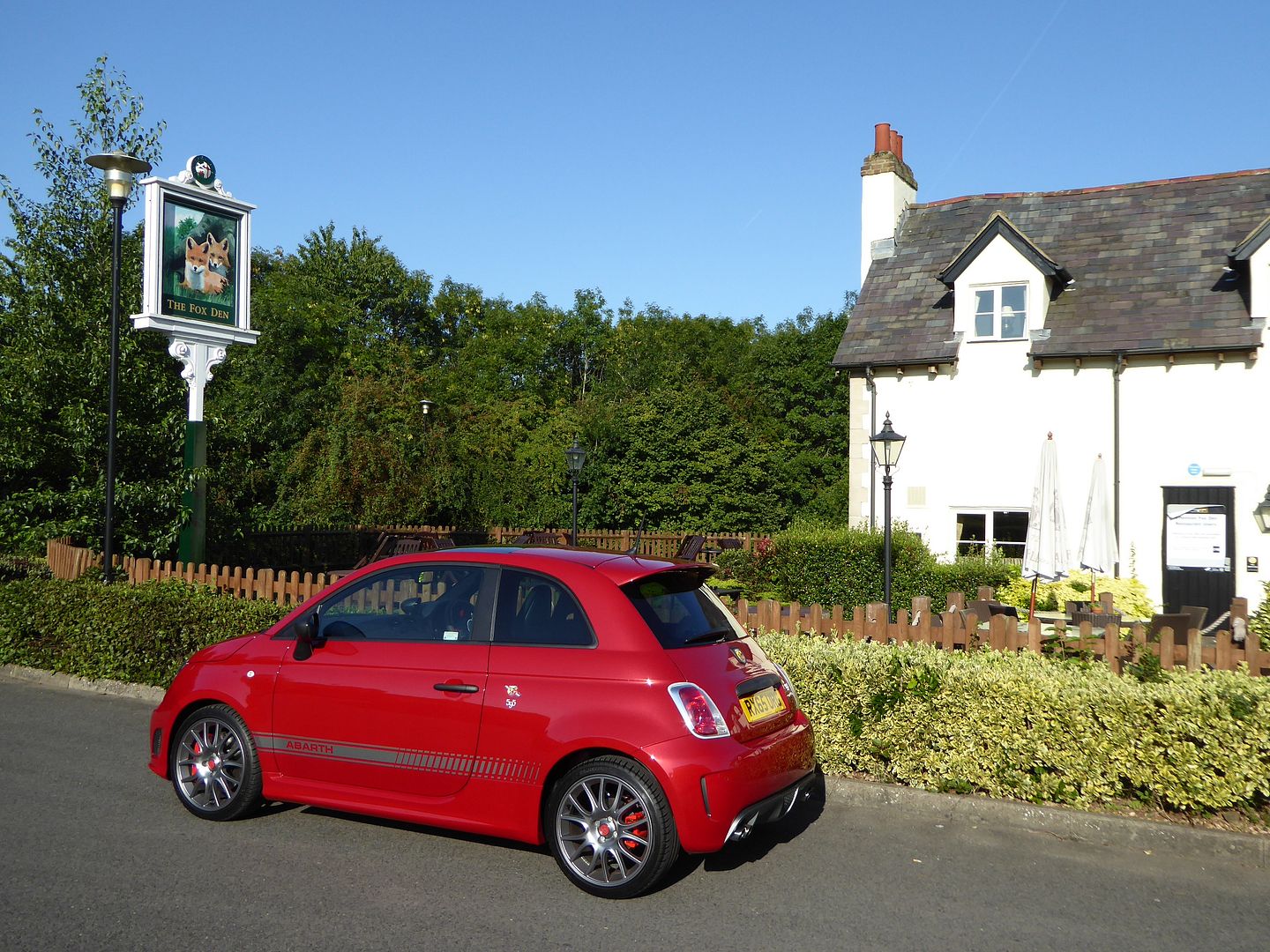
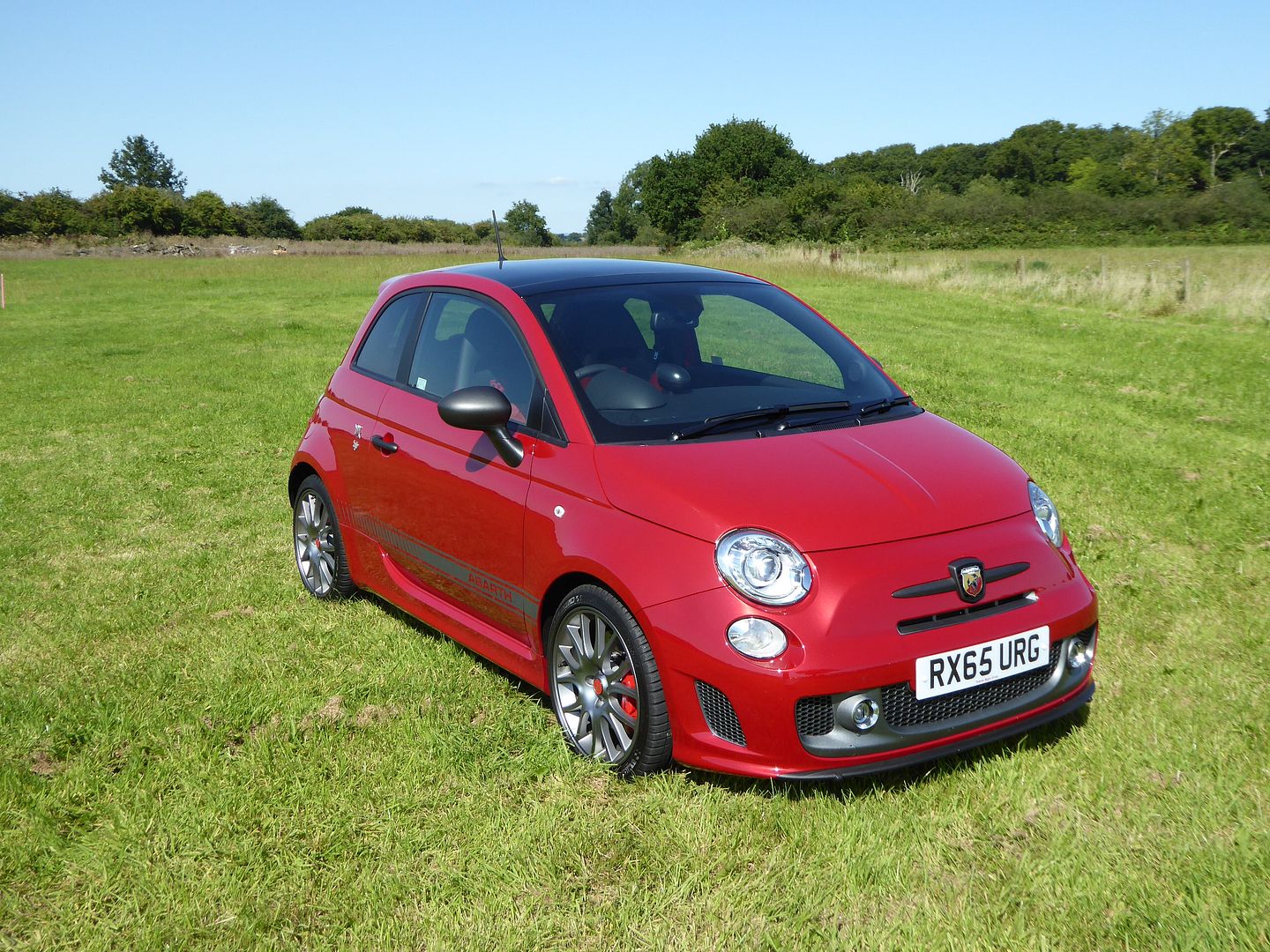
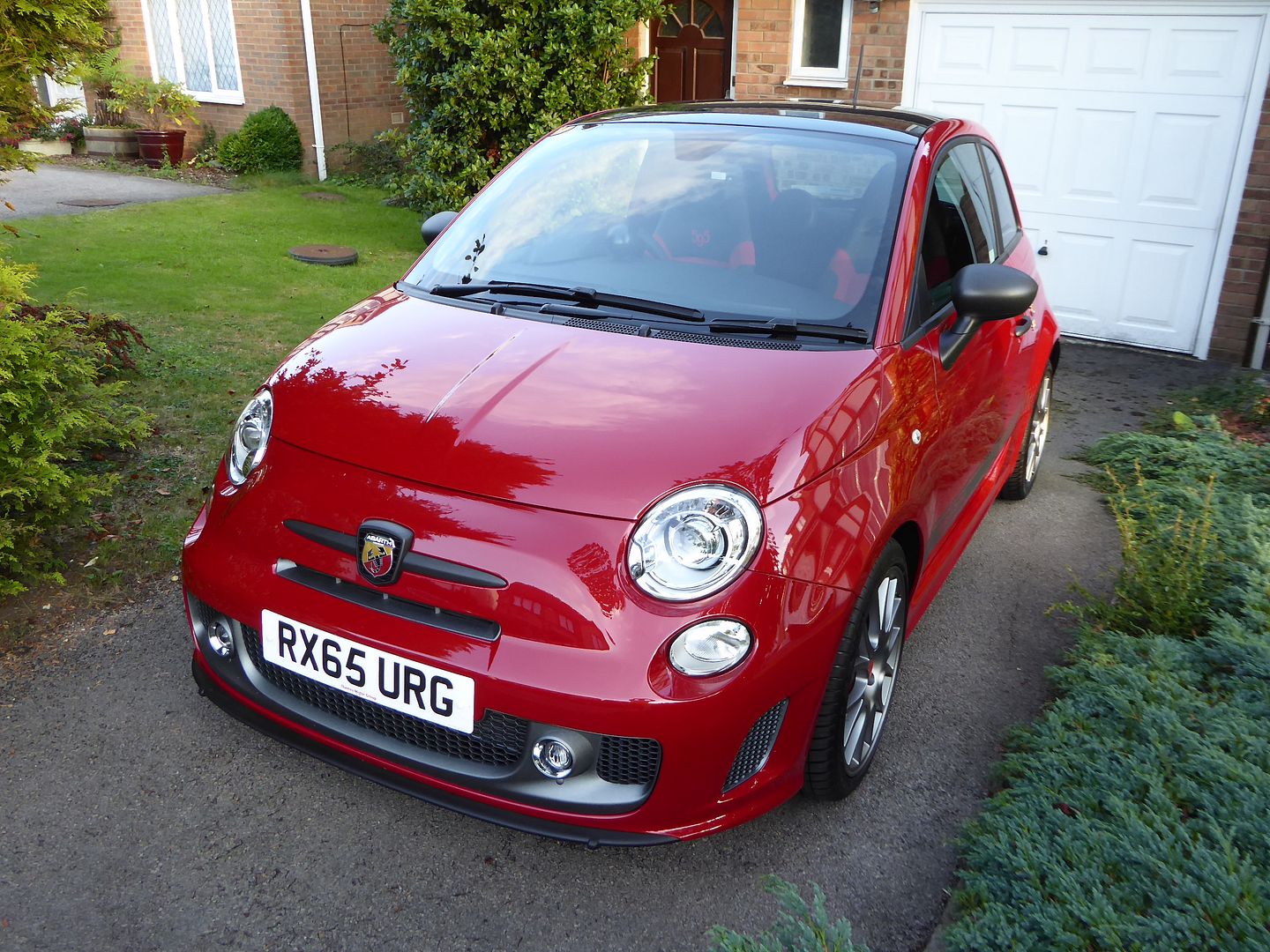
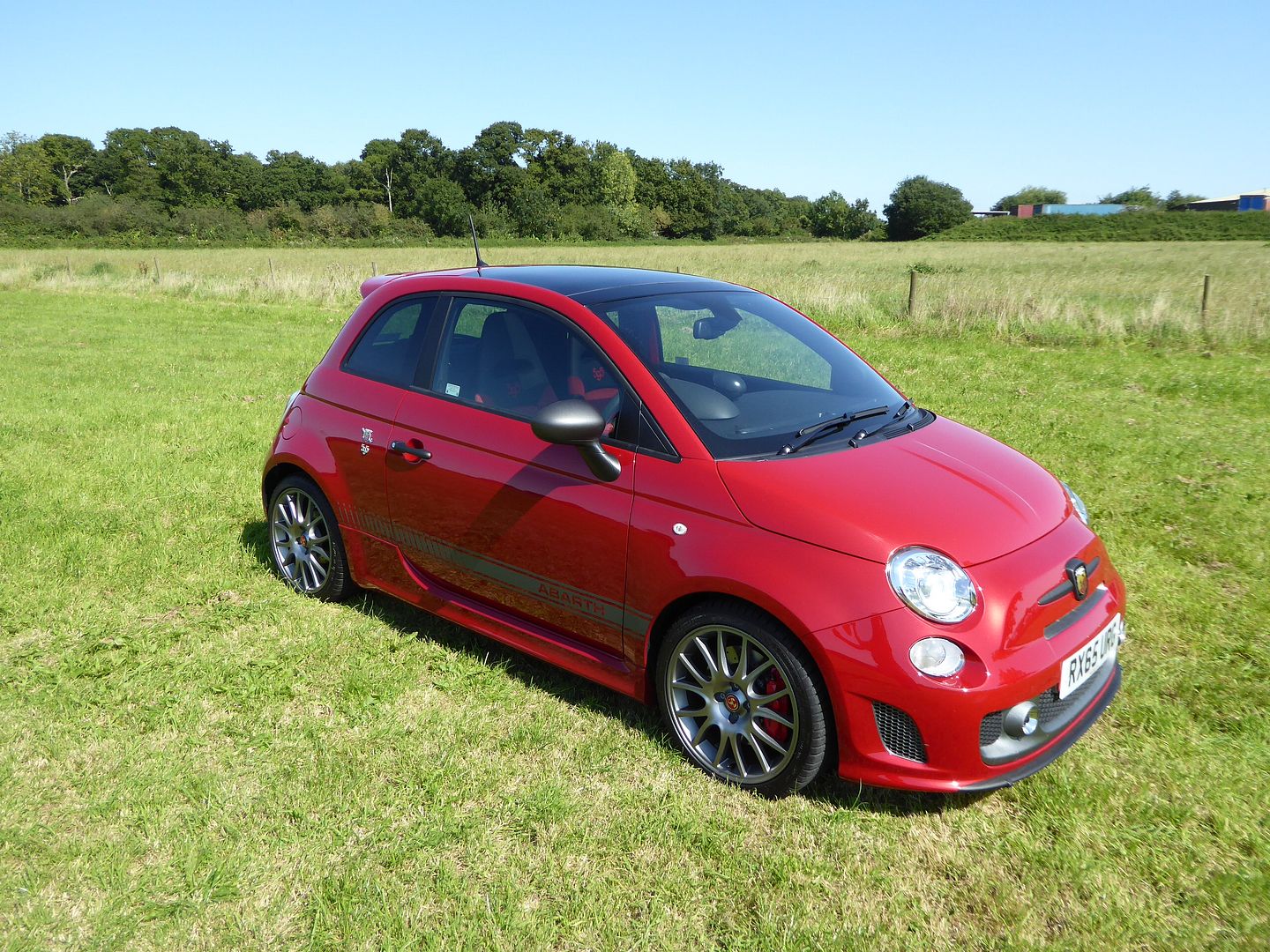
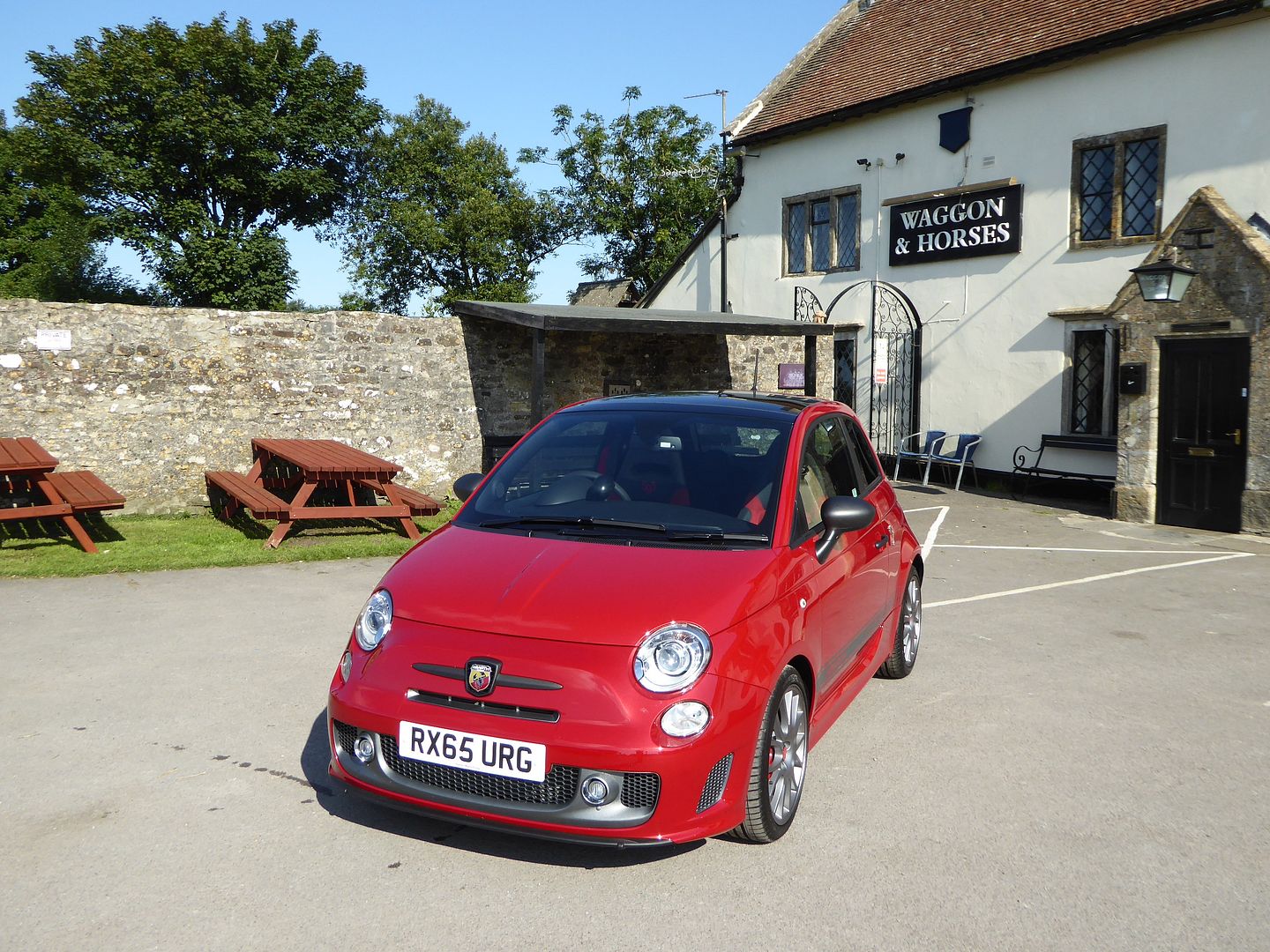
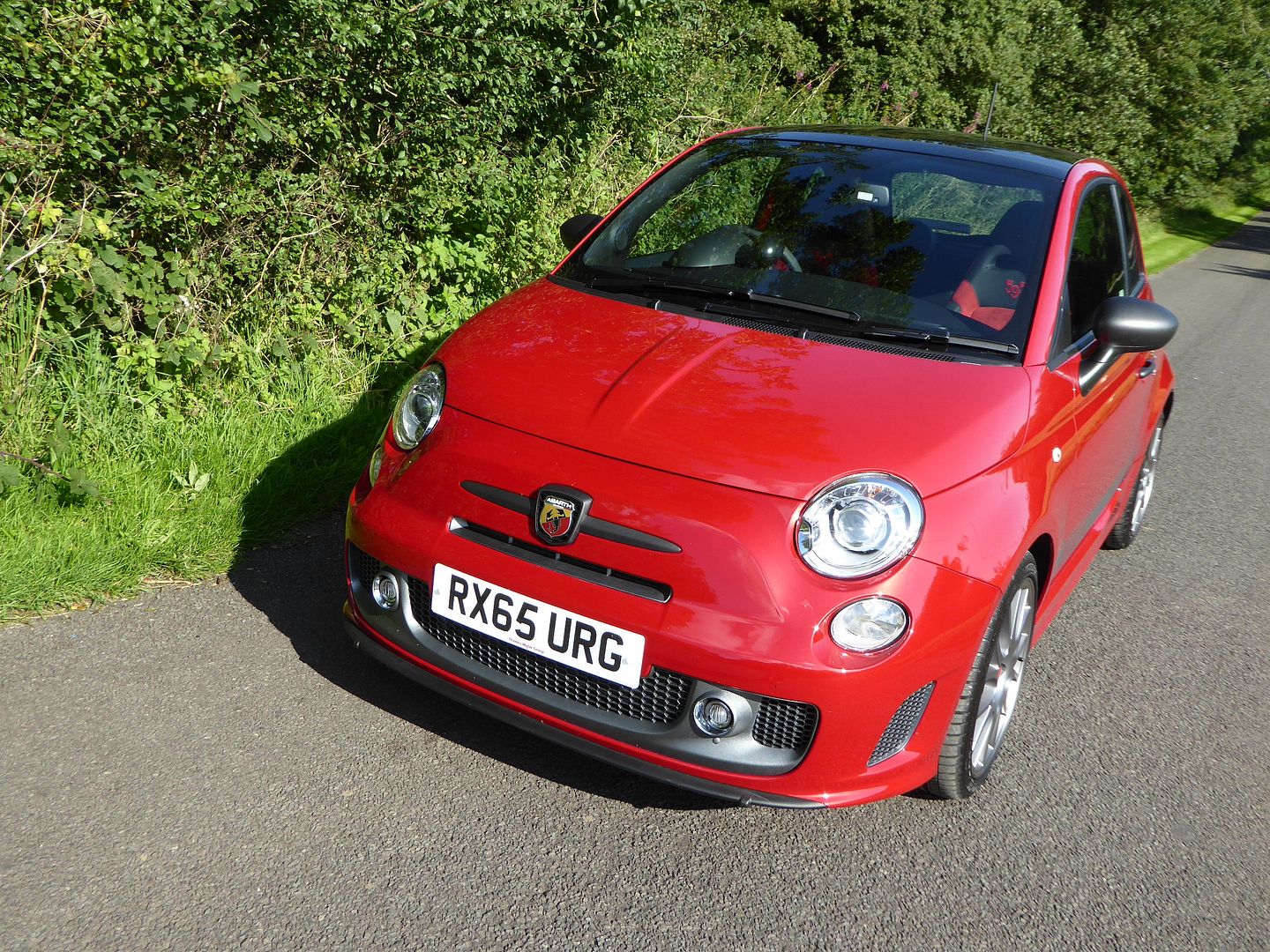
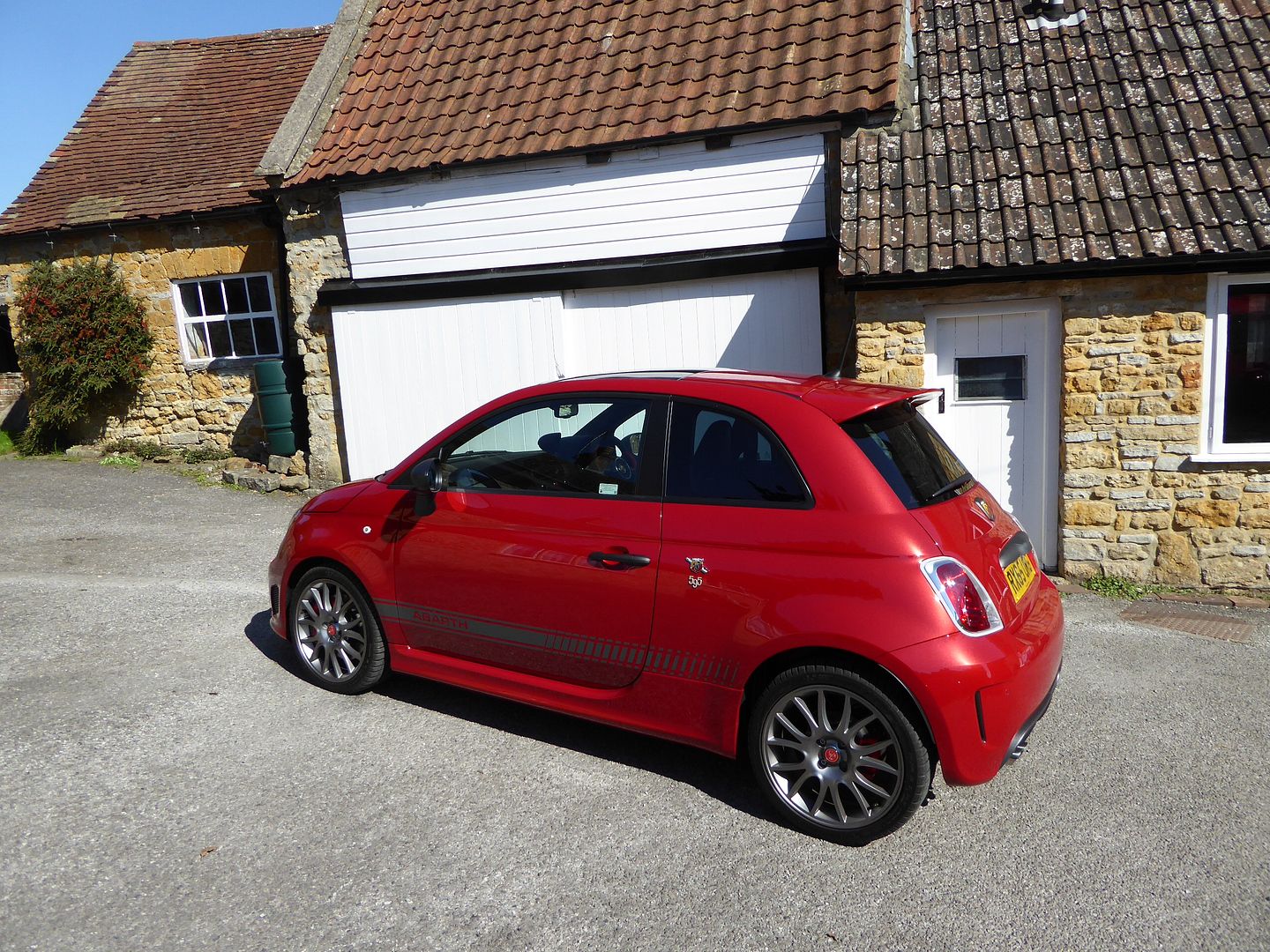
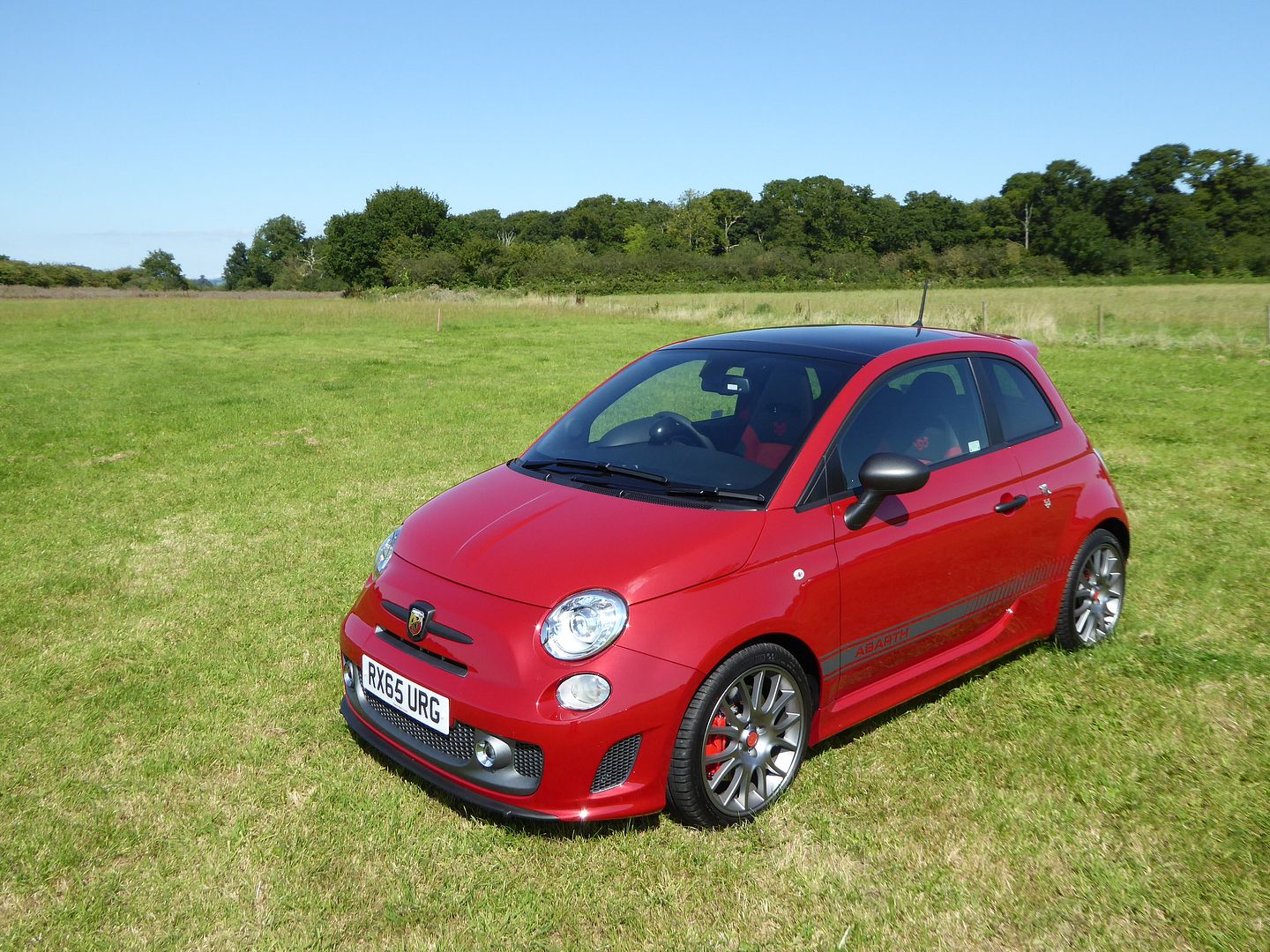
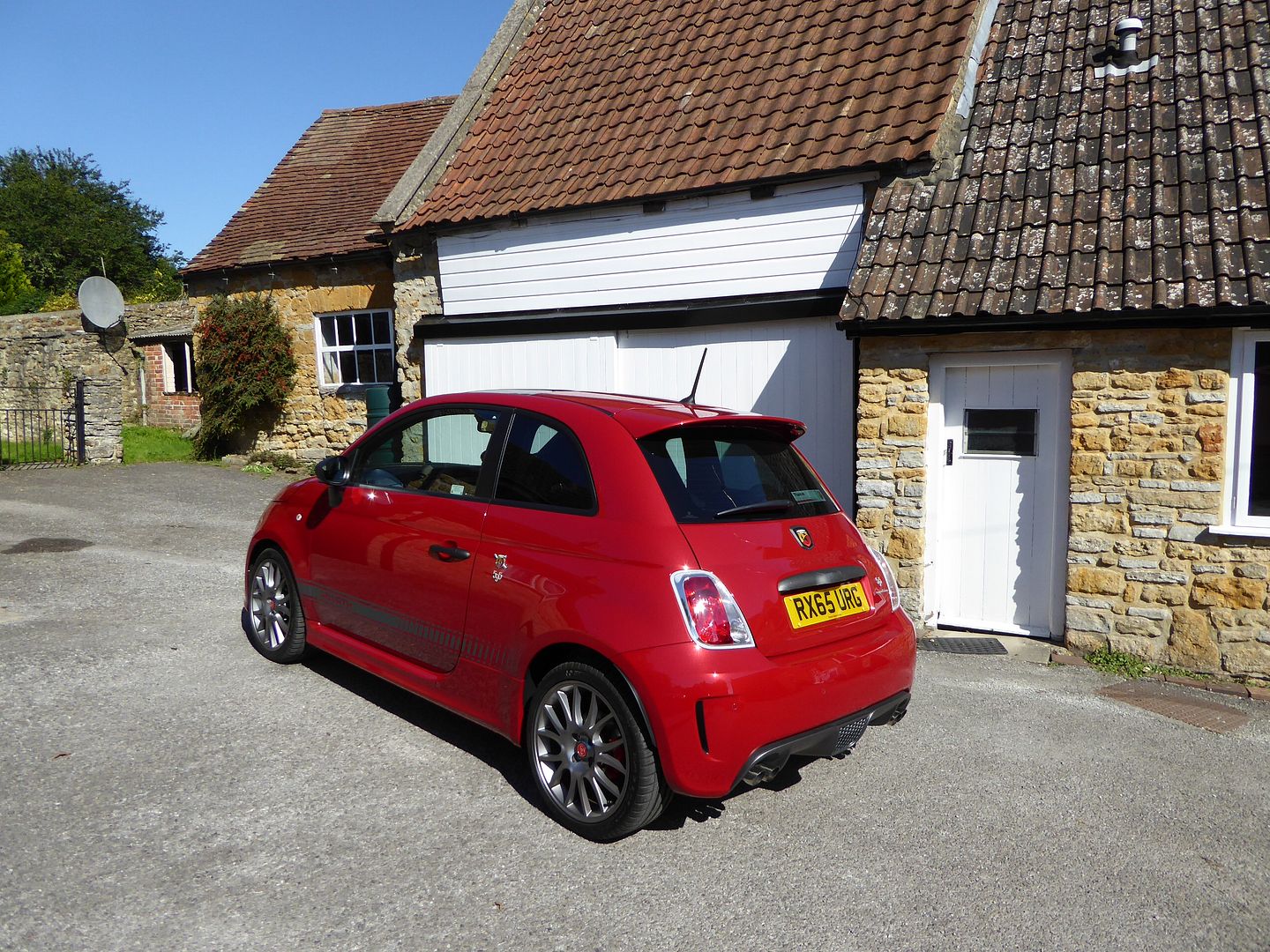
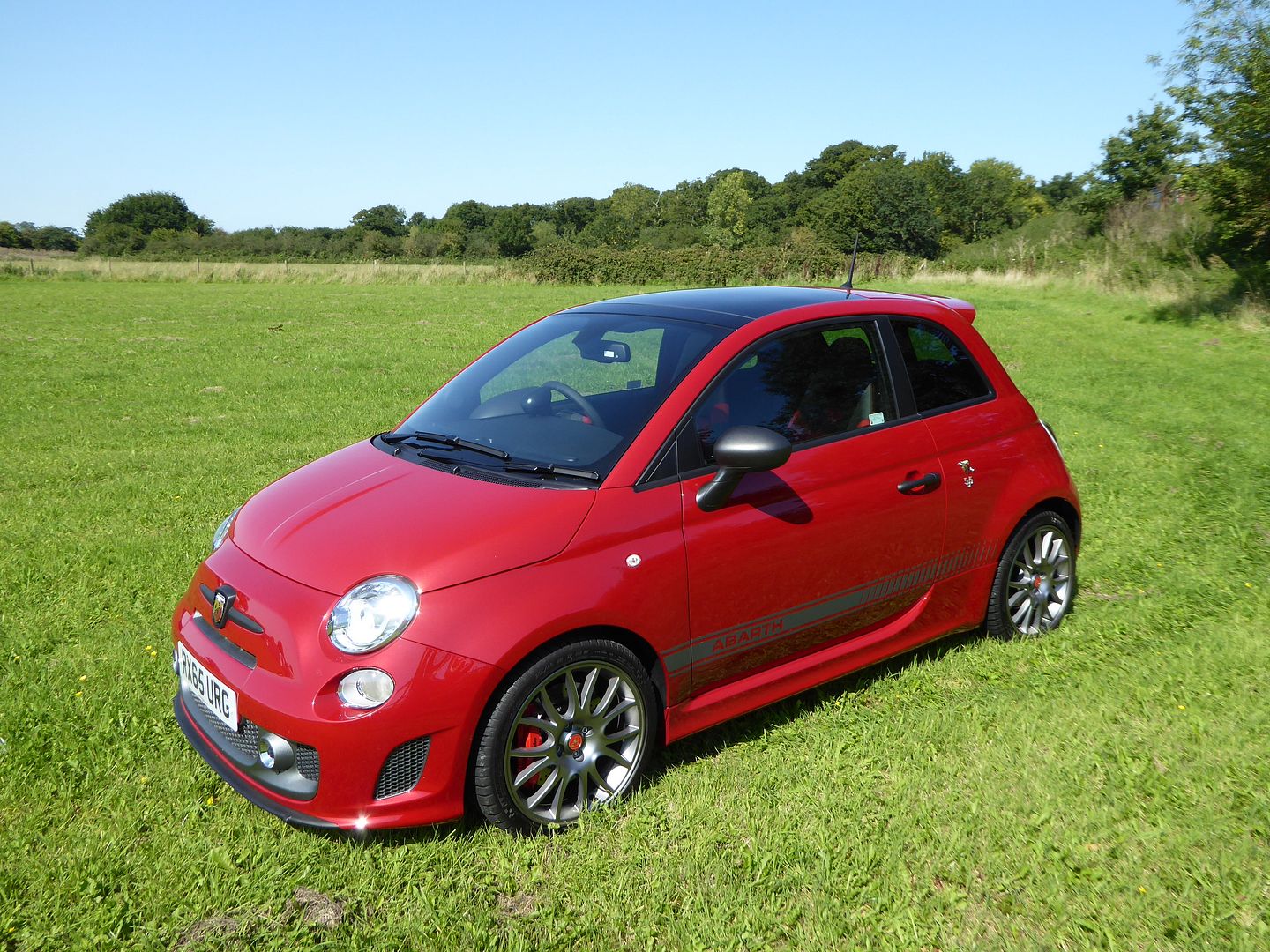
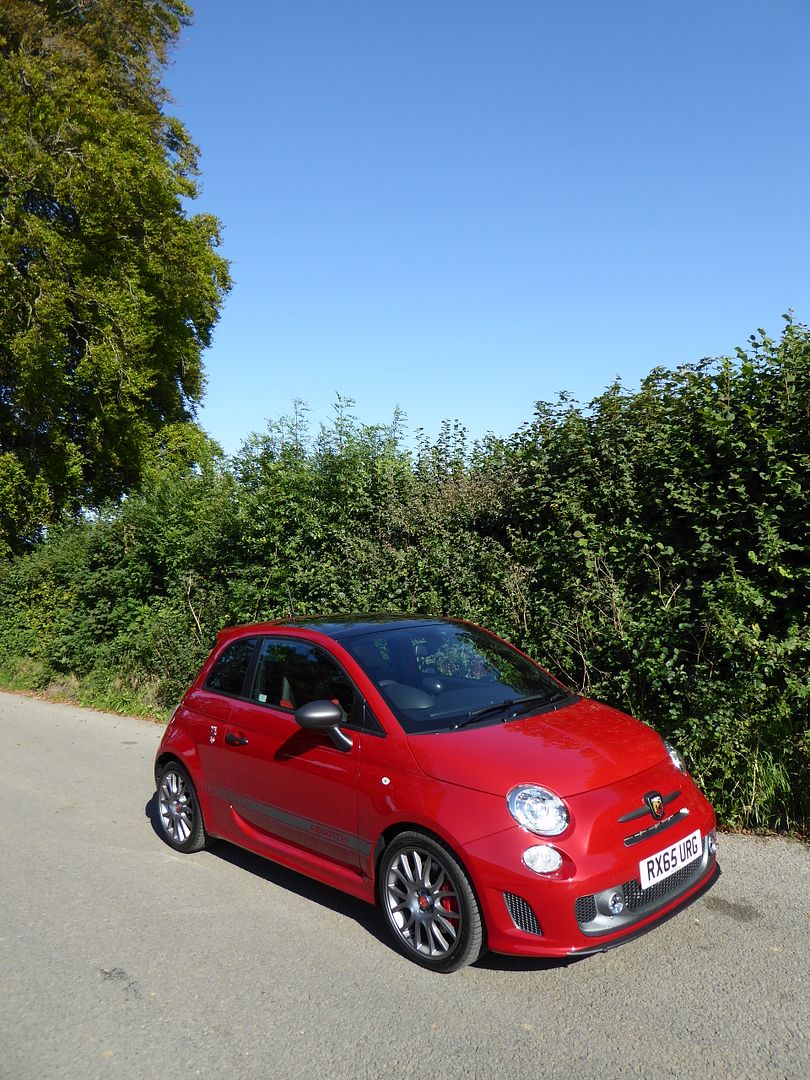
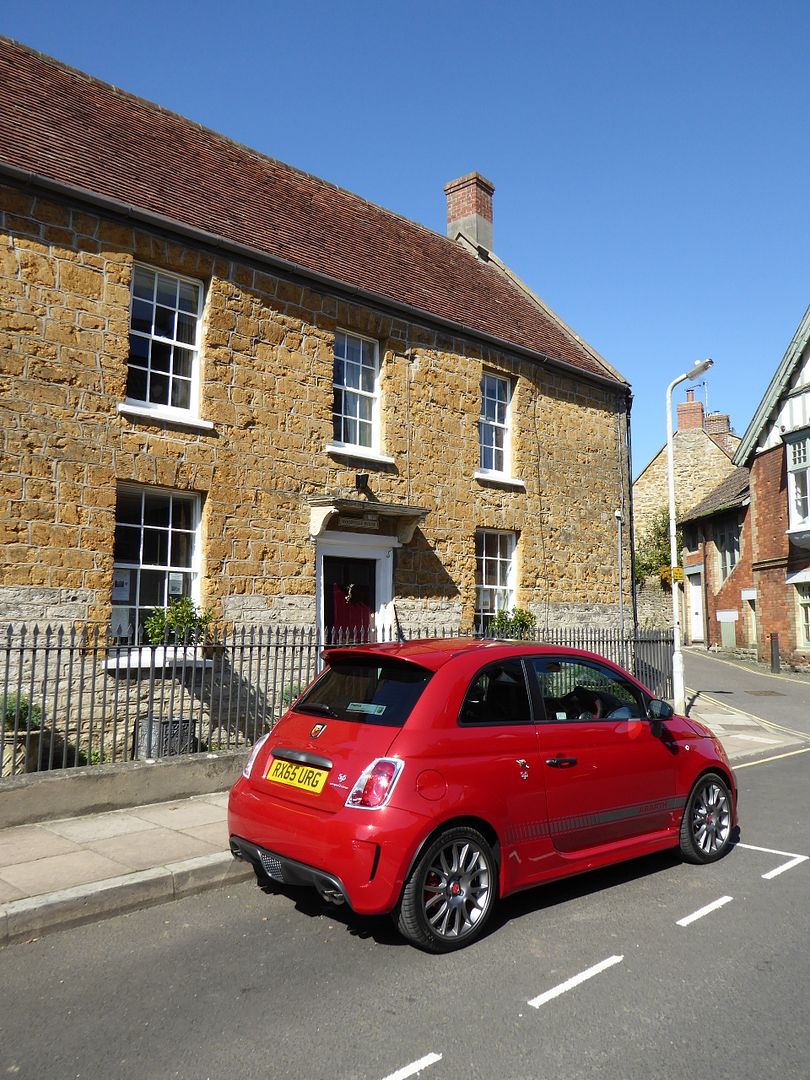
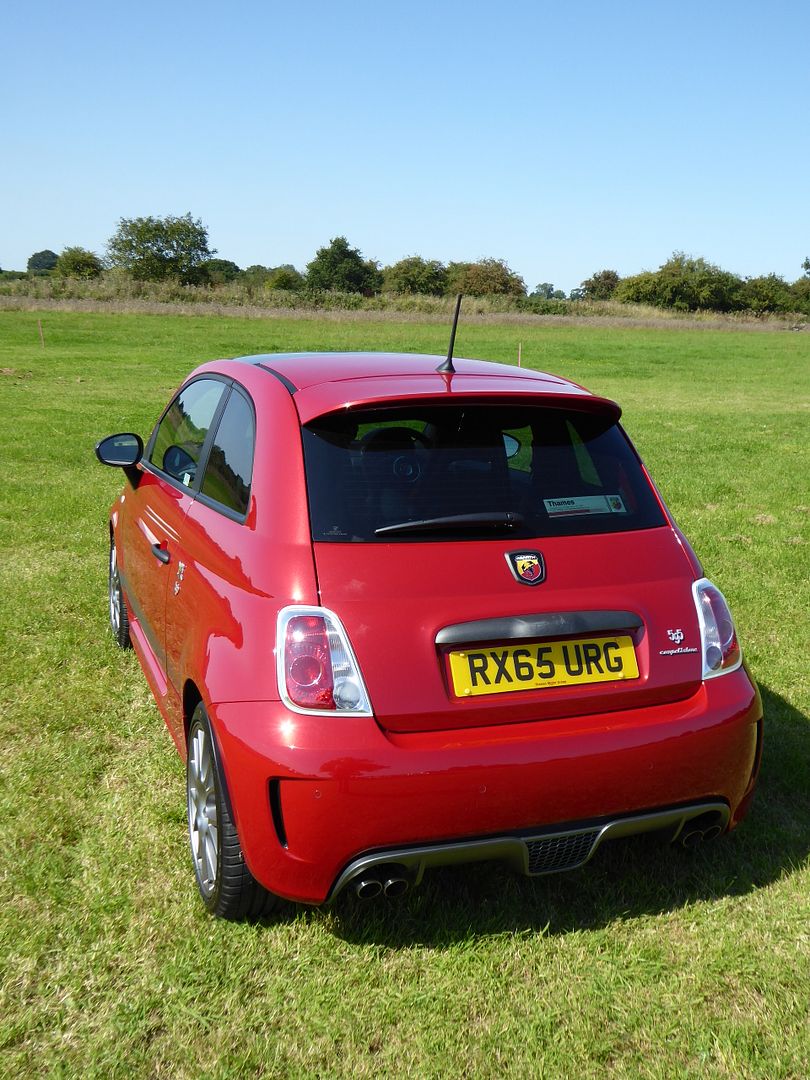
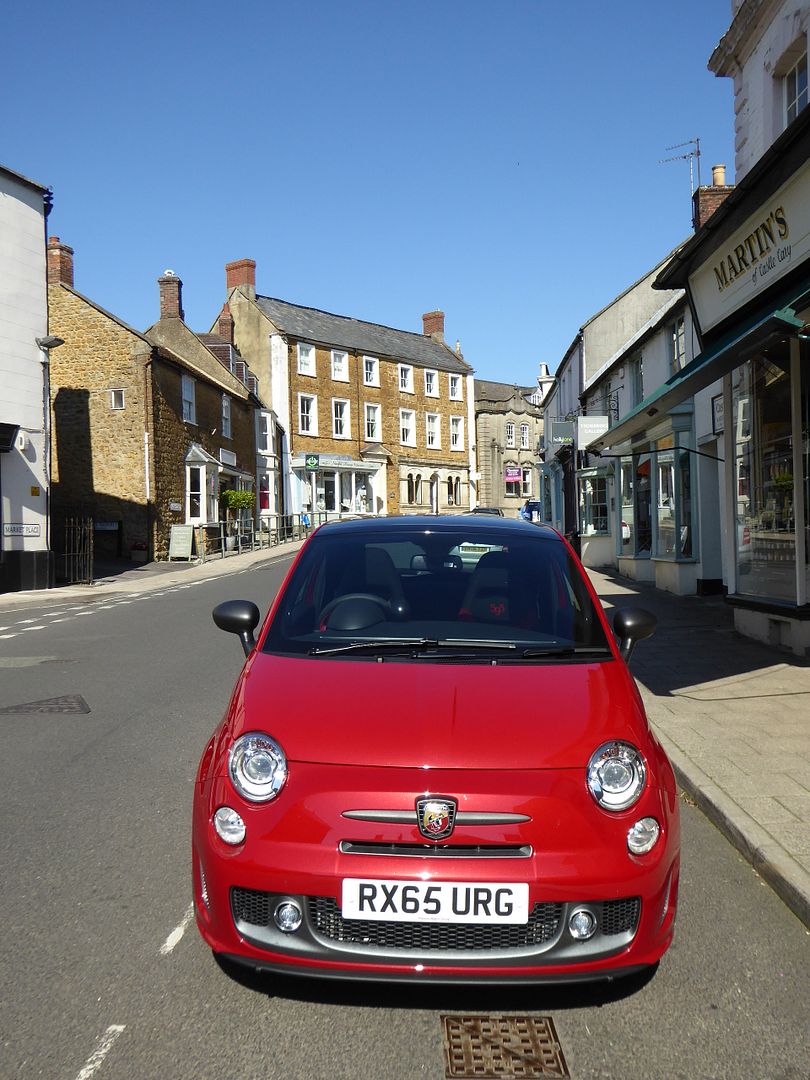
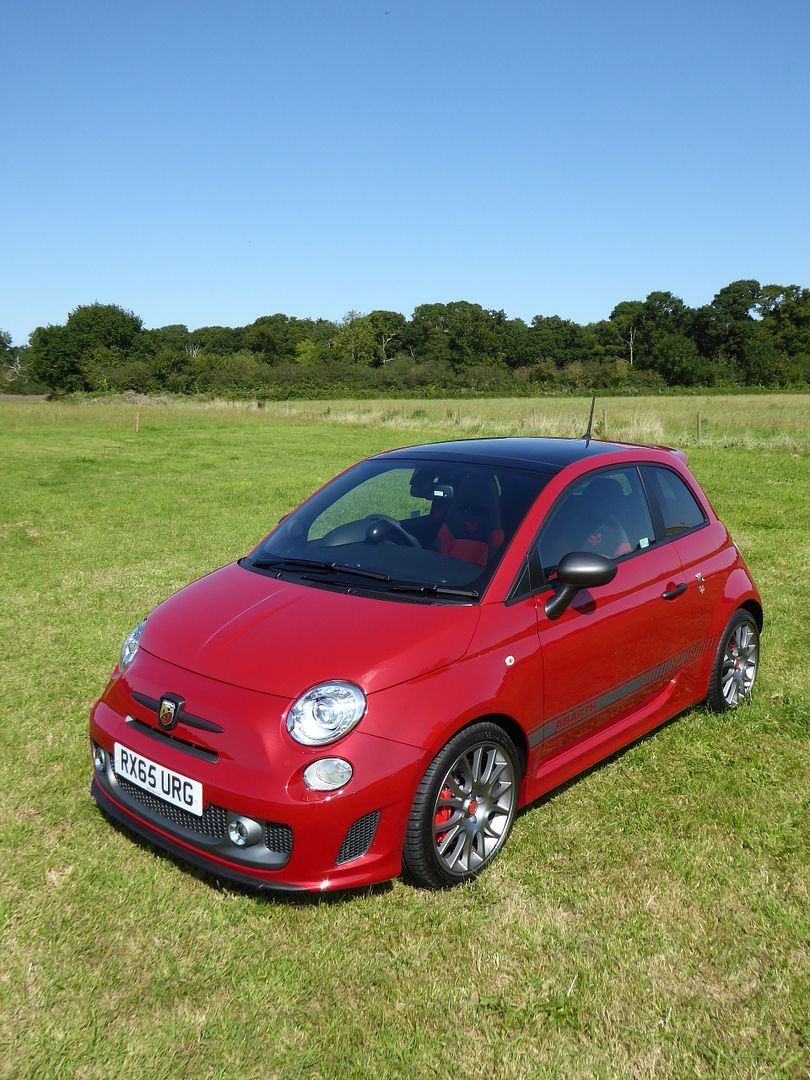
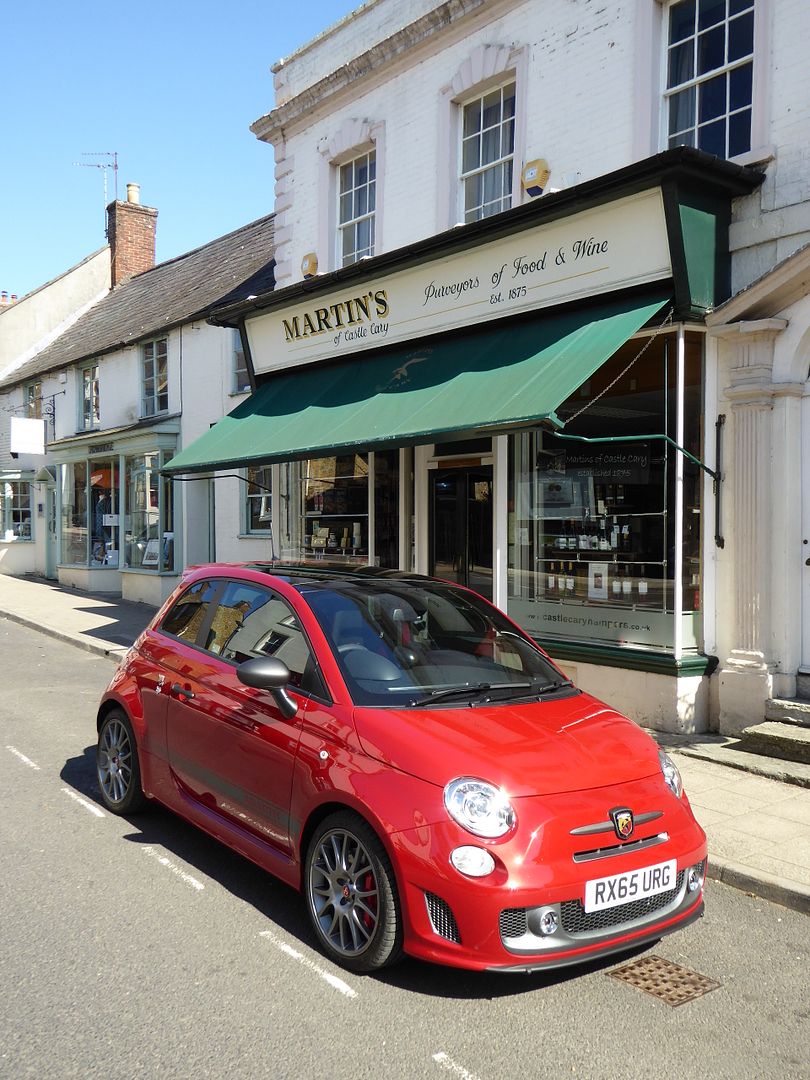
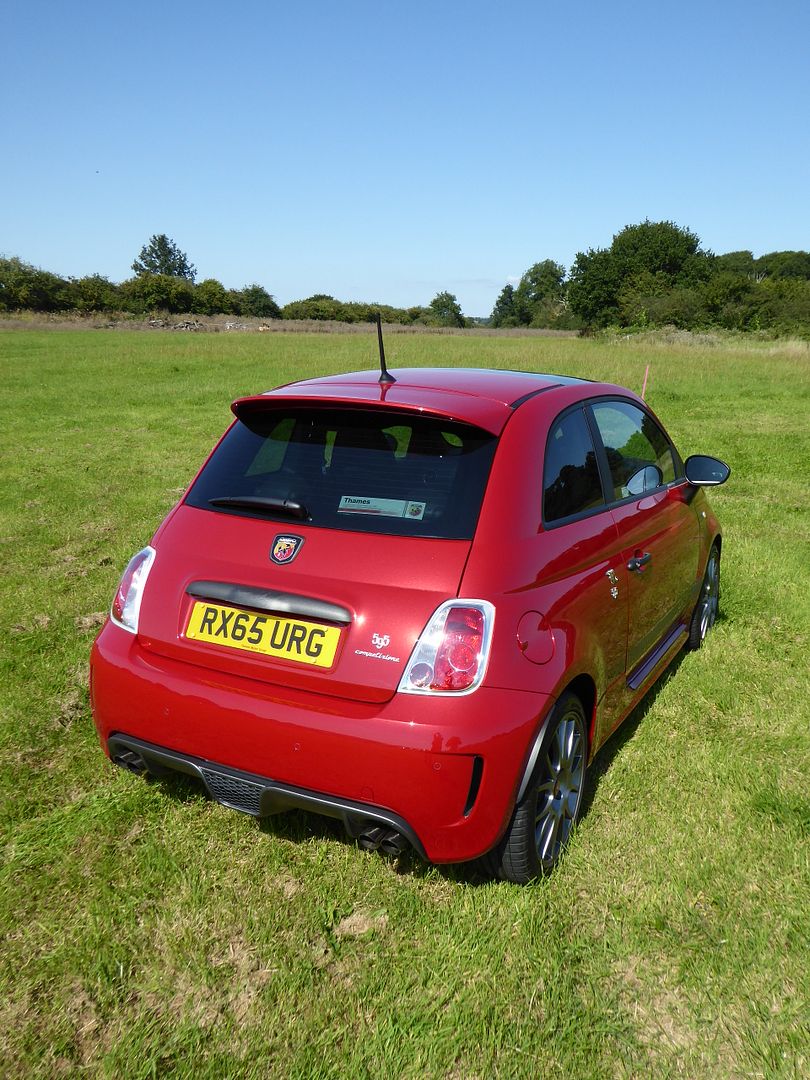
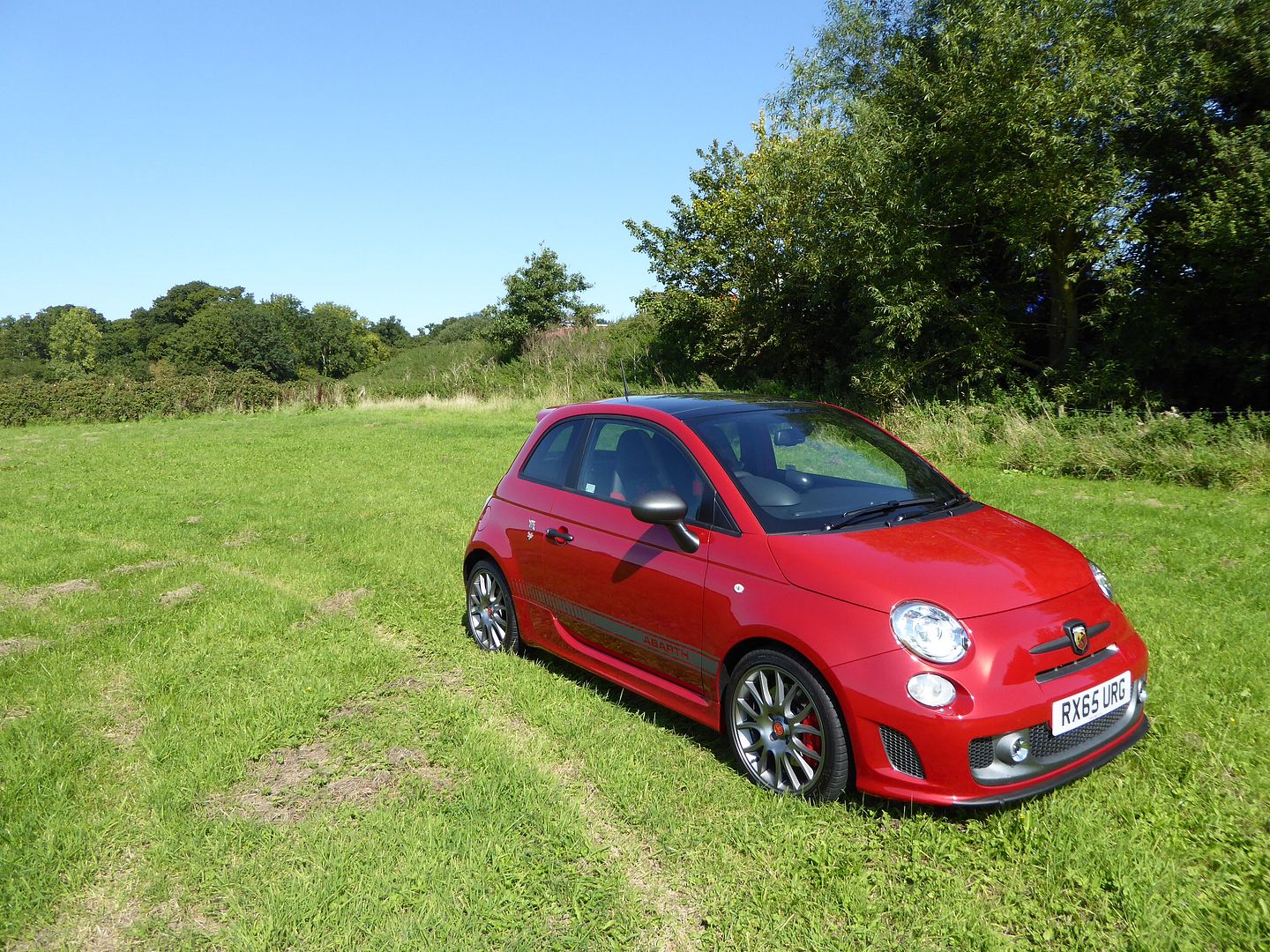
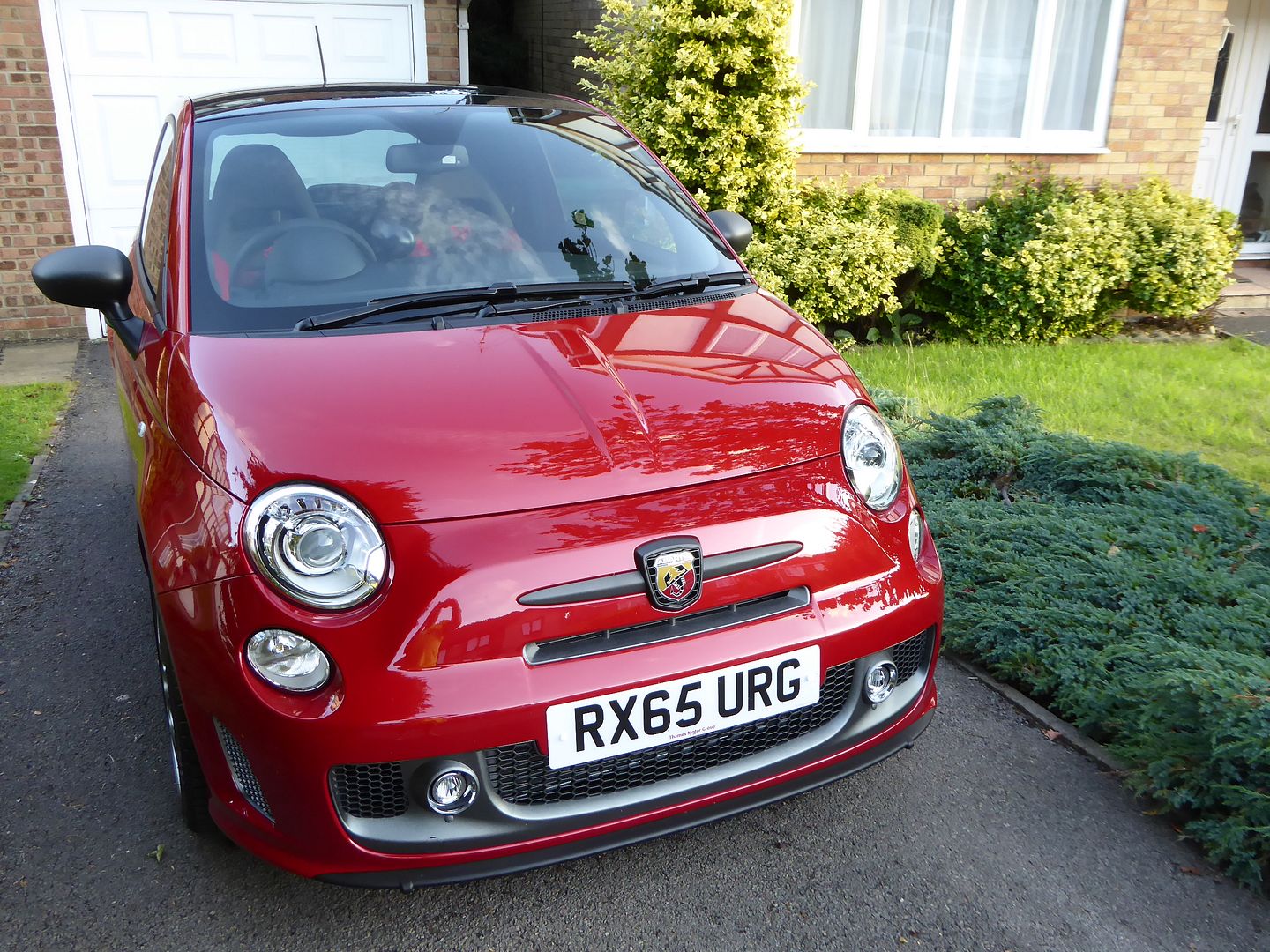
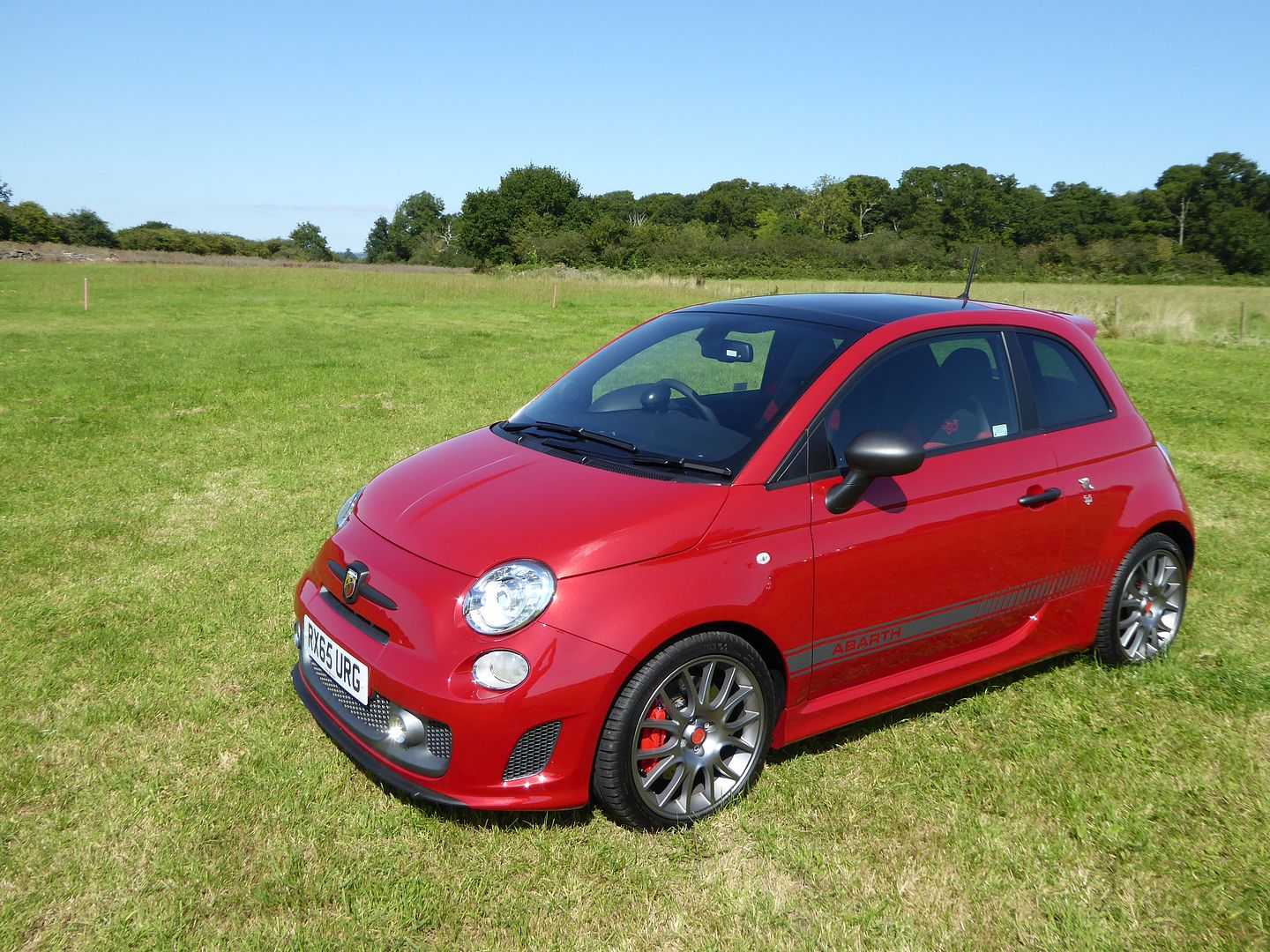
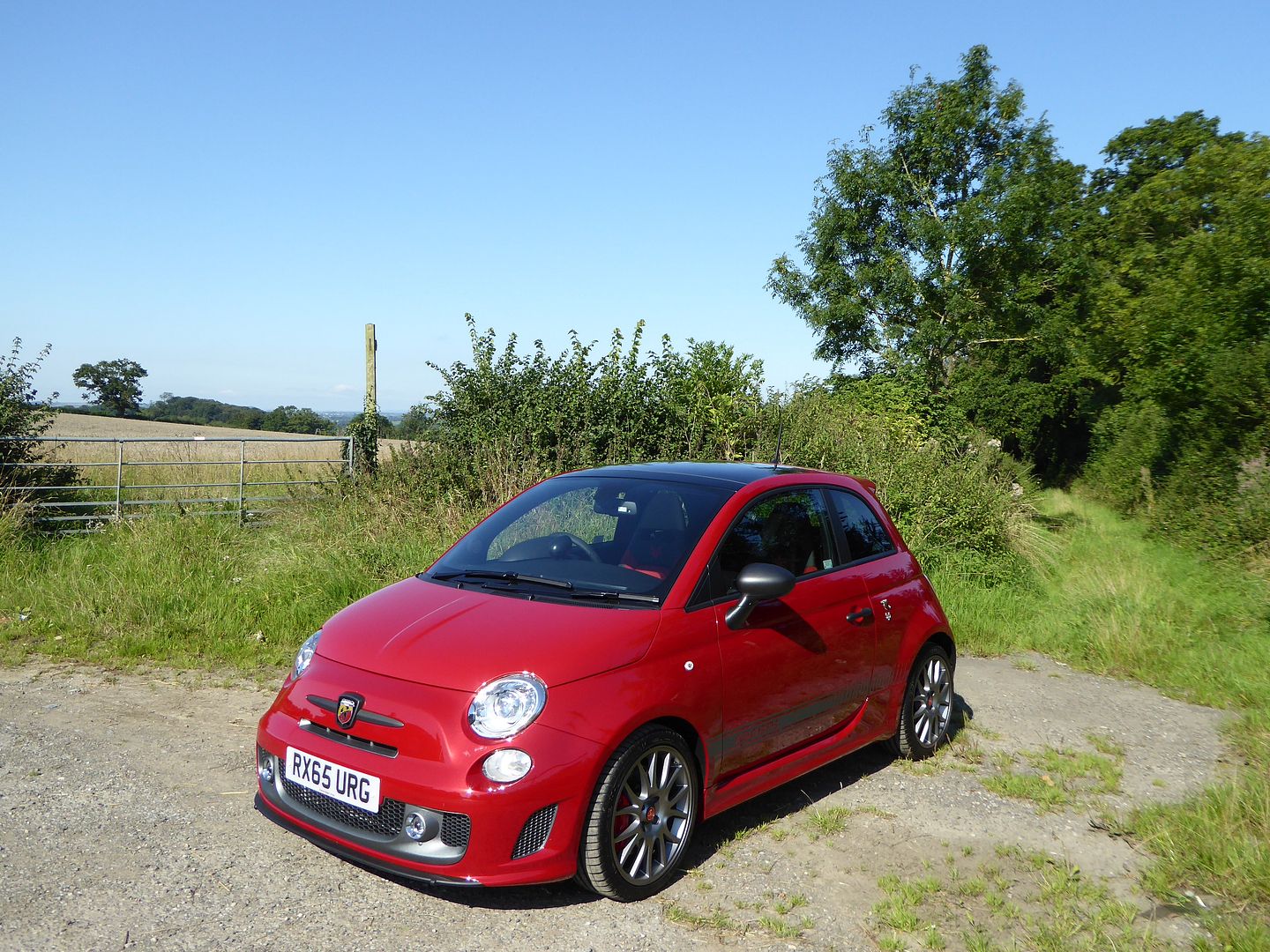

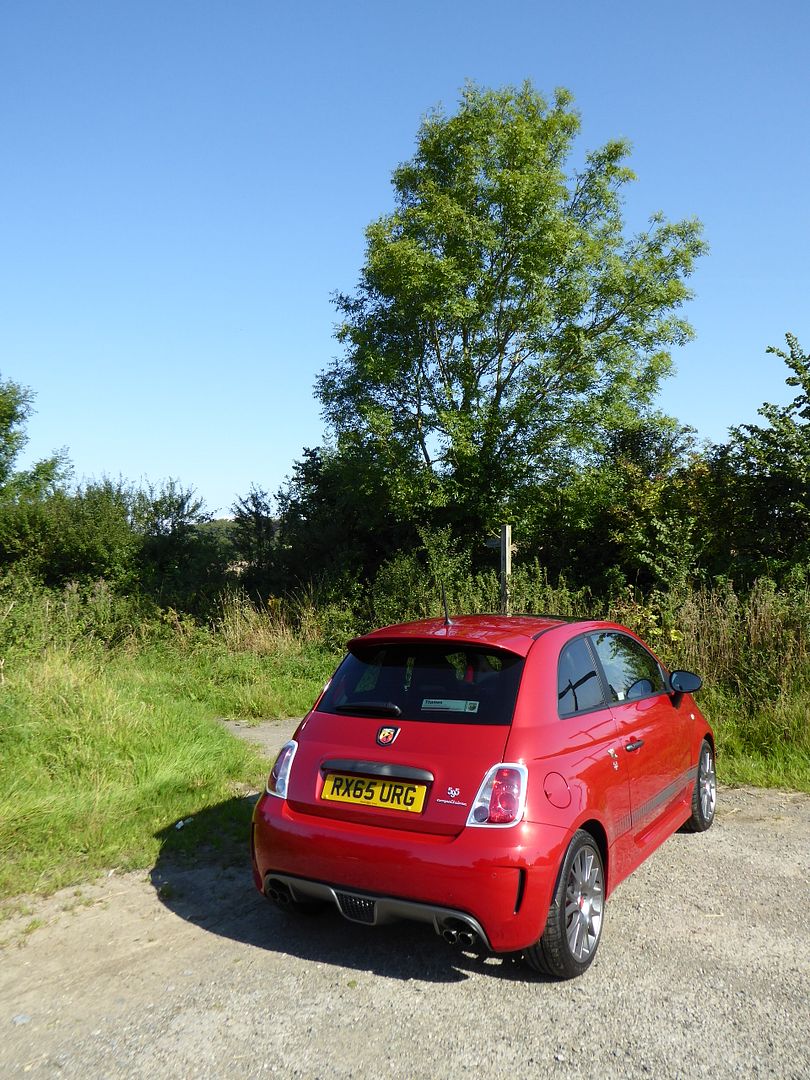

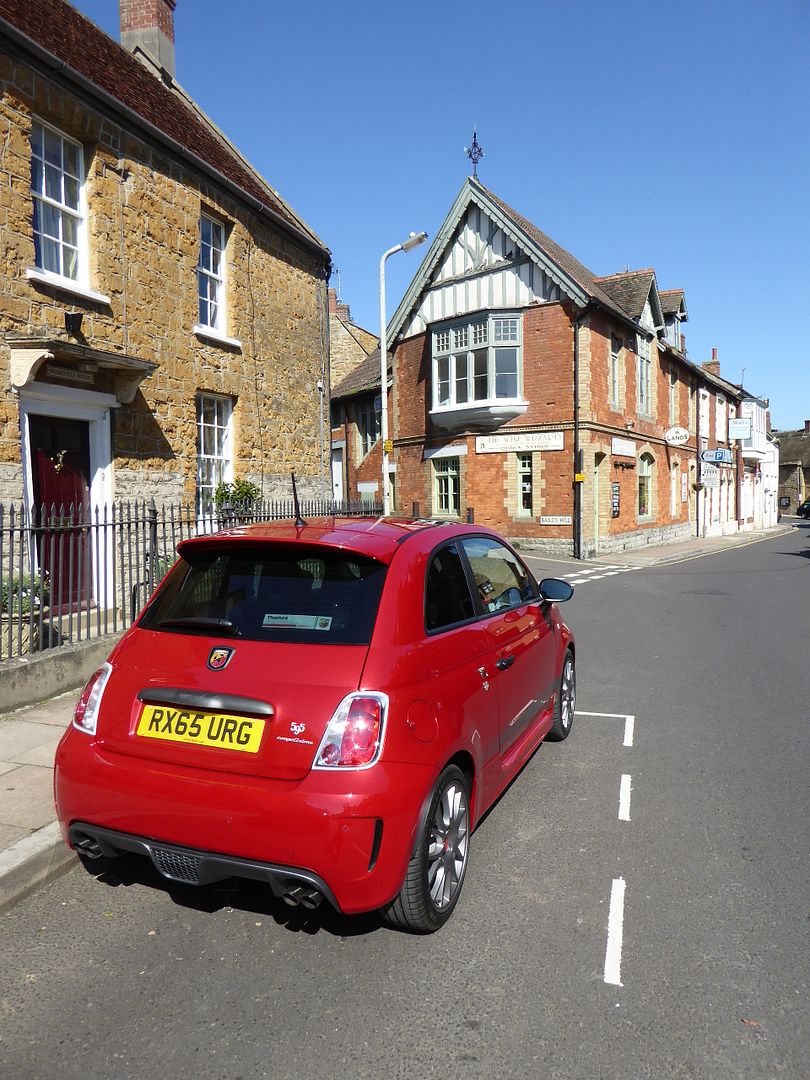
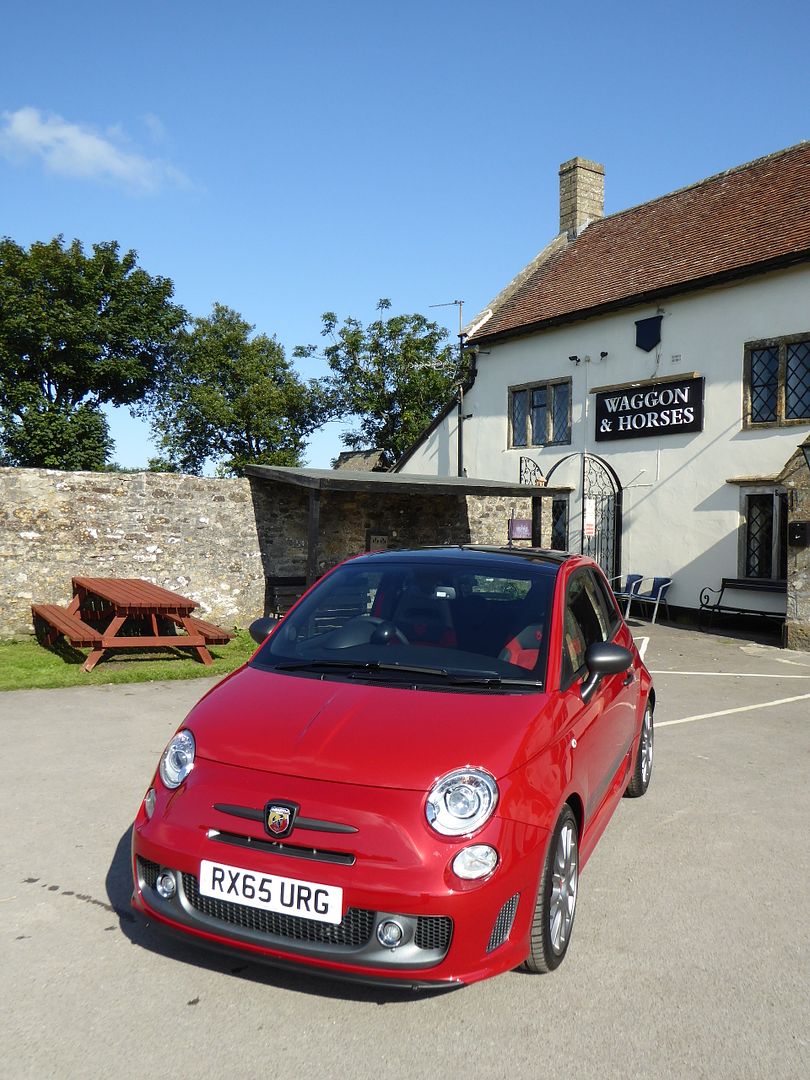
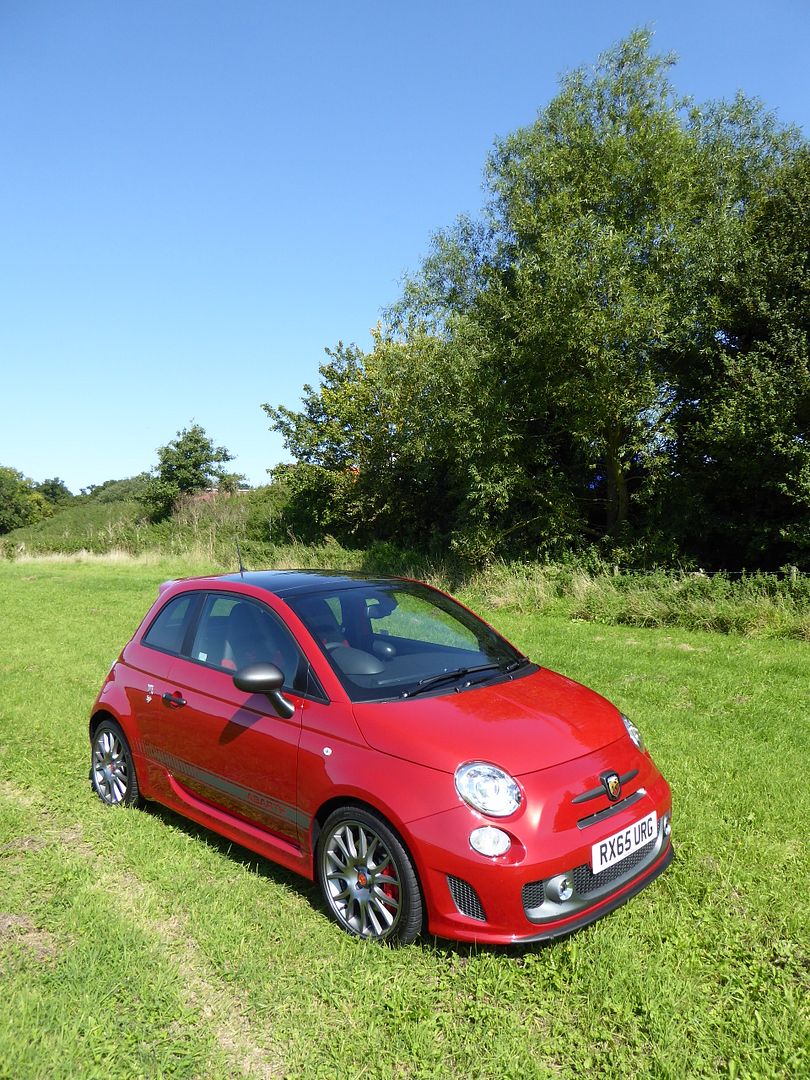
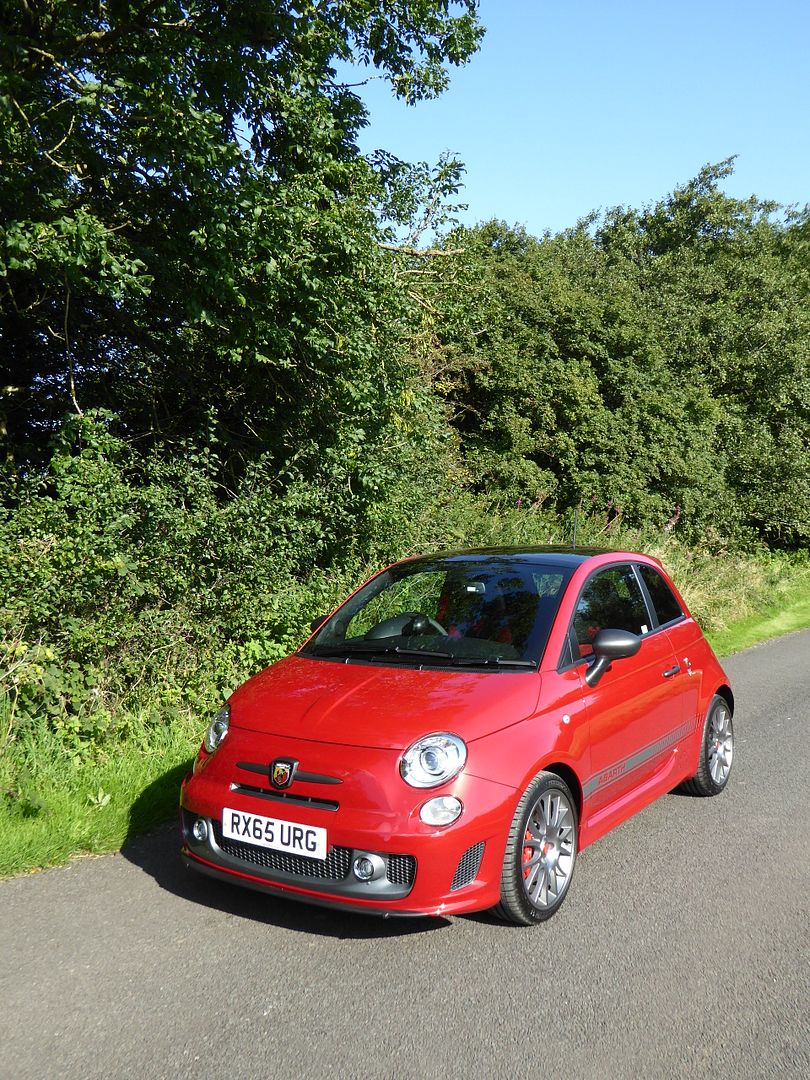
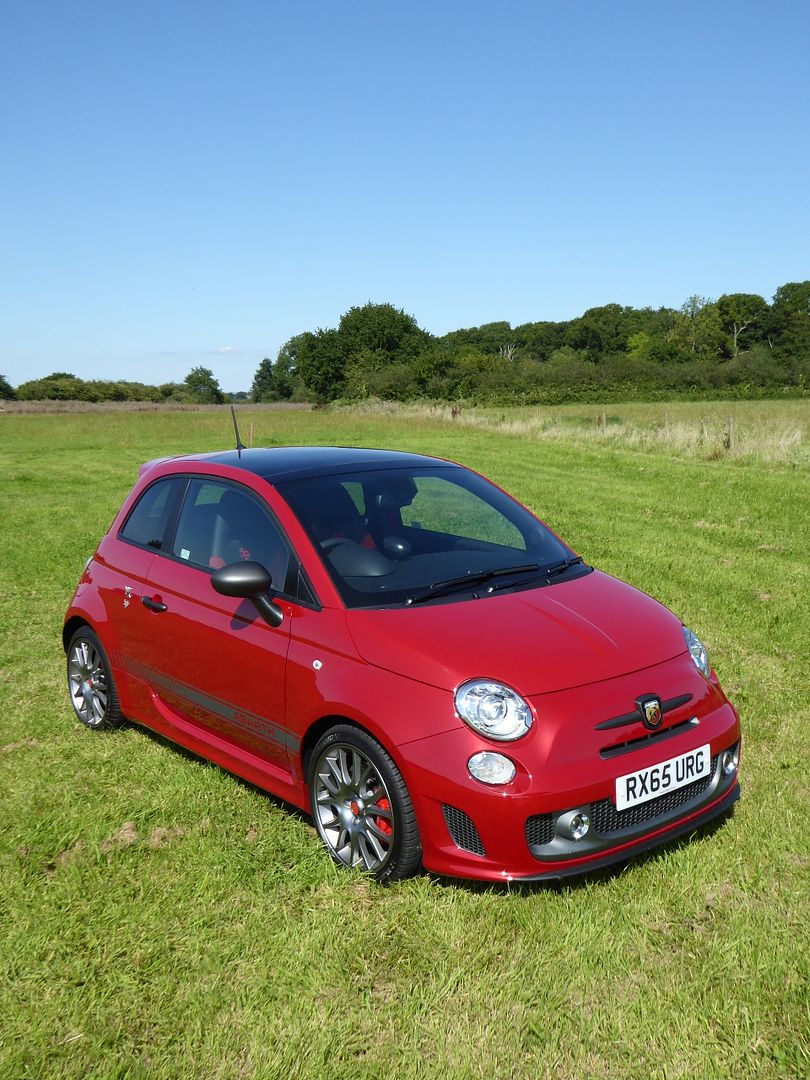
Although Abarth enthusiasts have been itching to find out more about the 180 bhp car ever since news of its imminent launch came to light late in 2014, it has received very little press coverage, and no drive reports that I have seen at all in the four months since the first cars arrived in the UK. All the focus remains still on the halo Biposto model. As one of the Abarth afficianados, and a delighted owner of a 135 bhp entry level car for over 5 years, you can imagine that I was as interested as everyone else who loves the brand and these cars, to find out what the new one would be like. Having had the chance to take a short drive in a 695 Biposto, a review of which has been posted separately, and been blown away by the sound and the evident extra performance that you get when there are 190 horses rather than 135 to propel a small and relatively light car, my interest in trying the 180 bhp car reached new levels. So, it should surprise no-one that I was on the phone to Ajay Paul at Thames in Slough to see if he had a car I could try. He had. I was on site with him a matter of hours later!
One of the most endearing, and surprising features of the Abarth is the noise the car makes. Fire the standard car up, and you can pretty much guarantee that heads will turn, puzzled, looking for something far larger than the small car from which the rather throaty sound is coming. To be honest, though, those outside the car get more benefit of this than those in it. Unless you have the window open, you will not hear very much once underway, at all. That’s not the case with the Competizione model. That is down to the standard Record-Monza exhaust system. Always available as a (costly) option on the earlier cars, the surprise news with the Competizione models is that it is now formed from stainless steel and hence should last far longer. Developed specially for the initial Abarth 500 cars, it is a variable back-pressure system capable of improving the performance and the sound of the engine and making it more characteristically “Abarth”, very much in the tradition of the legendary 1960s cars. The key design feature of the exhaust is that there is a central pipe of constant section with side passages through the fibreglass, and the elimination of all diaphragms to minimise exhaust gas compression. This simple but innovative system is what gives Abarth exhausts a clear advantage in terms of performance, and an unmistakable sound. The latest system follows similar principles, with a ‘dual mode’ design with variable back pressure and a flap operated by a spring that improves the sound of the engine especially above 3000 rpm.
Many guessed that the 180 bhp would be delivered by the Multi-Air engine which is installed under the bonnet of Mexican built models that are sold in America. But no, the trusty T-jet remains, but with a larger Garrett turbo to help force more air through the system. It’s effective. I’ve read quite a few observations that Euro 6, which this car complies with, of course, has made some of these cars a bit hesitant off the mark unless you are quite firm with the throttle pedal, but I’ve certainly not noticed this. It could be that as the engine’s decibels increase with every prod of the throttle that my foot is just eager to treat the ears with some more of that glorious sound and so I’ve always given it enough revs to make a rapid getaway. Once on the move, though, the extra power is very obvious and the first time I accelerated away, I was well aware of the fact that this car has a good 35% more power than the one I have become used to in the past 5 years, which is itself no sluggard. With a quoted 0 – 60 time of just 6.6 seconds, though, this really is a very brisk pocket rocket indeed. Power delivery is smooth, and there is no evident turbo lag. The manual gearbox still has five forward ratios, and I understand that this is all it ever will, as there is simply no space in the casing for another set of cogs. Whilst a sixth gear was something I sometimes I felt would benefit the 135 bhp car, as it would have reduced the noise levels for steady speed motorway cruising, which whilst not loud were still louder than relaxing, this car, perhaps because of the different power characteristics is just that bit quieter on the motorway, so the need for another ratio is not really apparent. There is certainly no hardship in using the gearlever. The change quality on my 135bhp car was pretty good, though it always needed a fairly firm hand. This one feels a lot smoother, with the lever flowing very precisely, between the gears. There is a nice spherical metal gear knob which is particularly pleasing not just to look at, but to touch as well – though I may not agree with this when (if) we get a blisteringly hot day. There was never anything wrong with the steering and handling of the early cars. Indeed, these were among the real strengths that made the car such a joy to drive. There is a nice chunky steering wheel with a slightly flattened bottom to it which is just the right size and thickness to hold and it is the interface. With a wheel in each corner of the car, and a relatively short wheelbase, this car really does feel like a little go-kart with an amazing level of handling and grip, making it a lot of fun to punt down a twisty road and also to take roundabouts at almost improbable speed. There are electronics to help you, of course, with the TTC (Torque Transfer Control) the most obvious, and selectable. There is a button for this on the dash, and those who know what they are doing, can turn it on, if they really want. It works like a sort of limited slip diff, using advanced electronics to redistribute torque between the different wheels, helping to give greater control and grip in extreme driving. Not perhaps necessary for the road, but a useful feature for those who take their Abarths on the track. They will probably also appreciate the Brembo brakes, now standard, which give a big improvement in the stopping power of the car from speed, though this is a feature out on the road which I have not tested. There is still a conventional pull-up handbrake between the seats.
The ride was the price you paid for the go-kart like handling of the early cars, with opinions somewhat mixed as to whether the choice of 16 as opposed to 17″ wheels made any significant difference. No matter how you assessed it, it was rather hard, and on some surfaces a bit bouncy. The Koni FSD dampers were said to improve matters somewhat, and they certainly do in this car. Although the Competizione is never going to win prizes for cossetting and wafting its occupants gently down the street (and it is not that sort of car, let’s be honest!), it does feel rather more composed, with rougher surfaces that troubled my 2010 car now feeling far smoother. Add that to the lower noise levels and it will make longer distances that bit less frenetic. You will still be stopping relatively frequently, though as the fuel tank only holds 38 litres. I have averaged 38 mpg over 5 years in the 135 bhp car, and all the indications are that the Competizione will deliver something very similar. It would appreciate a higher octane fuel than 95, though. Completing the driving attributes, visibility is the same as in the earlier cars. That means that because of the rather thick rear pillars, there is something of a blind spot when reversing, or at oblique junctions, though judging the back of the car itself is easy, and there are no issues seeing forwards, or using the good field of view from the door mirrors. Parking sensors come as standard on the Competizione, and these beep discretely at you as you near an obstacle. Xenon lights are standard, and there is a marked difference between these and the standard halogen ones. The first time I drove the car in the dark, I was amazed at just how much light was available.
Inside the Competizione, the most obvious change compared to the early cars is that the main dash panel is no longer finished in the same colour as the external paint, but in a sort of dark grey with a slightly texture to its surface. It looks smart, though many will lament the retro look that was endowed by that splash of colour. It is not the only change, as when what Fiat called the Series 3 500 models were launched in 2014, the instrument dial was changed to an all digital Thin Film Transistor (TFT) display. It still occupies the same single unit, in a circular dial which evokes memories of the old Nuova 500, but this is definitely mid-Teens technology. Open the door and a bar lights up across the unit, emblazened Abarth. Turn the ignition on, and the display illuminates. The rev counter is still on the left, but the speedometer is now a digital display in the top centre of the unit, and the area on the right is now given over to some sort of economy gauge. Smaller display areas in an inner concentric area show water temperature and fuel level, leaving the centre of the dial clear for digital display of various data points. You can cycle through these by pressing the button in the right hand column stalk end, and can choose from a series of trip computer displays, a tyre pressure monitoring system or, if the car is in Sport mode, a g-meter, showing cornering forces. The graphics are crystal clear and easy to read in the day as well as at night. Everything else is exactly as it always has been. UK market cars still have a Turbo boost gauge mounted on top of the dashboard, to the left of the instrument dial, and there is a display in the centre of this to tell you whether you are in Sport mode or not. The centre of the dash contains twin air vents which sit above the audio unit. Doubtless at some point, this combination will be replaced by the new uConnect set up that features in the 2016 model Fiat versions, but for now, you get something which is easy to use but a bit old tech in appearance. Dual zone automated climate control is standard on the Competizione, and this is operated by a series of flush mounted buttons in an area below the three buttons for Sport mode, hazard warning lights and rear fog lights. Slightly unusually, the electric window switches are also mounted in the centre of the dash, on the area above where the high set gearlever is to be found. Everything else you need is operated from the chunky pair of column stalks, with lights a twist function on the end of the indicator stalk and wipers on the right of the column. The rear wiper comes on when you select reverse if the front wipers are in use. There are wheel mounted controls for the audio unit and the Blue & Me Bluetooth connectivity. This last was a doddle to set up, pairing it with my phone. Everything feels solid and robust to the touch, and I can report that after 5 years use in the old car, it felt just the same, and there were no squeaks and rattles apart from an intermittently noisy bearing in the climate control fan, which was a known problem in early cars. I also think that the dash layout manages to look stylish without being overly fussy, something which still eludes the MINI, which trades form over usability even in its latest guise.
Most people look at the 595, or indeed the Fiat 500 on which it is based and assume that it would be too small to meet their needs. Maybe it is the diminutive parcel shelf that they spy, if the tailgate is open, or perhaps it is because they know that the MINI – a physically larger car – is so devoid of space for anyone in the back and the boot, but if you actually try to put people in the rear seats of this car, you can. And the boot is bigger than you might expect, too. Of course, there is not a vast amount of space, but there is more than you think. Getting into the back does require a modicum of agility, as indeed it always has with this bodyshell, and the 595, with its Sabelt seats does not make it any easier, as the backrests tip forward, but the seat base remains in situ, so you need to clamber through the gap. Once installed, though, there is a decent amount of space, especially if the front seat occupants have their seats set well forward. Sensibly, only two seat belts are provided, indicating that its maker thinks of this as a four seater and not one for five people. That means that shoulder room is certainly not a problem, and only the very tallest are going to want for headroom. You would not get four people’s holiday luggage in the boot, unless they were particularly sparing in what they packed, but there is ample room for a couple of squashy bags and a few odds and ends under that very small parcel shelf,, so shaped to fit the space between the rear seat backrests and the sloping rear of the car. Width of the luggage area is quite generous, even if it is not quite wide enough to take the bag with the poles in it for the Abarth Owners Club flags that I have to carry on a regular basis. That problem is solved by folding down one or both of the rear seats. These are not asymmetrically split, but 50/50, so you could carry one rear seat passenger and plenty of extra luggage. The backrest simply drops forward onto the rear seat cushion, creating a much longer load platform, though it is not quite perfectly flat. There is no spare wheel on these cars, but there is a bit of space under the boot floor, around the styrene moulding with the puncture repair kit in it for odds and ends. Inside the cabin, as well as door pockets, there are bins on both doors, there is a good sized parcel shelf in front of the passenger, and there are oddments spaces low down between the seats around the USB port for the Blue and Me. The opening cubby on the side of the console moulding was deleted a while back, but I never used it on my old car. There is also a glovebox. Many people take a while to find this. It is very small, and is hidden from view, opened by pressing a small plastic catch in the area above the parcel shelf, but hidden from view, and it drops down. It would be large enough for more than a couple of pairs of gloves. But not a lot more than that! Rear seat occupants get a pair of moulded cup holders in the rear-most part of the centre console, but nothing else in storage terms.
One of the main differences between this car and the entry level models are the Sabelt seats. A standard item in the Competizione model, these are something that any prospective owner needs to try out for themselves, as they will not be for everyone. The larger framed person simply will not fit, as there are significant bolsters on the side of both the cushion and backrest, which mean that if you are larger than the resulting space, you will find them too tight. Also, there is no height adjustment on the seats, so you need to make sure that there is enough headroom, and as the seat mounting, as is the case in all 500-based models, is quite high, this could also be a factor. That said, I am quite tall when seated, and I have no problems, even with the Skydome sunroof in the car, which takes a little off the available headroom. There is a manual adjustment for fore/aft and for the backrest, and the column goes up/down (but does not telescope in/out). So I have no difficulty in getting a good driving position, and I can report that if you do fit in the seats, they are very comfortable indeed, and those side bolsters really do hold you in place very well. If you do not fit, then it is a no cost option to specify the standard seats that come in the Custom and Turismo models.
Listed at £19.890, the Competizione comes pretty well equipped, with many of the cost options from the Custom or Turismo included as standard. As well as the mechanical upgrades of the more powerful engine, you get the Koni FSD dampers, Brembo brakes, BMC air filter, 17″ alloys and the Monza exhaust. Also included are the Sabelt seats, though as mentioned, you can swap these out for the regular shaped ones as found in a Turismo if you want (or need to if you don’t fit them!). Dual zone climate control, an auto dimming mirror, Blue and Me Bluetooth with an AM/FM audio unit with CD slot, MP3 and AUX ports, wheel mounted controls, front fog lights, xenon headlights with washers, parking sensors, aluminium fuel and oil filler cap and even a nice Abarth stripe down the side are all part of the standard package. That means that the options list is quite small. You have a choice of 3 different design alloy wheels, in three alternative finishes of titanium, magnesium or black in colour, 10 different single colour and 6 bicolore paint finishes, with Officina Red now being the no-charge colour, more stickers for the bonnet, sides, roof and tailgate, and a tilt and slide electric glass sun roof, the Skydome. This car includes that, as well as the Cordolo Red tricoat pearlescent paint that featured on many of the launch edition cars, and which costs £660. Other options include the Convertible body, the MTA automated gearbox, and a yellow finish to the brake calipers. Deciding may be hard, but ticking boxes on the configurator will not take long, as there are not many options to select. That assumes you have already decided to overlook the Custom and Turismo models, of course. Bargain of the range, the Custom starts at £14,660. It comes as standard with the 140 bhp T-jet engine, 16″ 8-spoke anthracite alloys, cloth seats, air conditioning, a leather wrapped steering wheel, with wheel mounted controls for the audio system, the TFT instrument display, a tyre pressure warning system, and split folding rear seats Options include almost all features available on the more costly cars, such as the same choice of colours as on the Competizione, a number of different wheel designs, some at 17″, leather trimmed seats, the Skydome electric sun roof, rear parking sensors, xenon headlights, various stickers for the sides, roof, bonnet and tailgate. Ticking all the boxes will result in a bill exceeding that of ordering a £16,090 Turismo. The main difference there is that this car has the 160 bhp engine as standard. Many have been sold with the two tone bi-colore paint work, though this is an £860 option as it is on the other models. You do get 10 spoke 17″ alloys included, though, leather seats and climate control also come in the package along with Turismo branding on the door kick plates and rear parcel shelf, and aluminium fuel and oil filler caps. Over the years of attending Abarth meetings, I don’t think I’ve ever seen two cars that are exactly the same, so although you might think there is limited potential to choose, actually even before getting to the after-market additions that are popular, there’s ample opportunity to personalise your Scorpion.
Most of the test cars that I review here are sourced from car rental companies, and the remainder tend to be loan cars, supplied by a garage when one of my cars is in for service or other work. But the car seen here is different. It is not borrowed, or rented. It is mine. When I bought the first Abarth in 2010, I said that it was a car that I would potentially keep “for ever”, or at least for a very long time. It was not my daily driver, so the mileage remained relatively low, needing its first big 18,000 mile service on its 5th birthday, so it had plenty of life left in it, but the allure of the 180bhp Competizione proved just too tempting once I had driven it. The sound of the Monza exhaust was probably the most beguiling thing about the test car, but the extra performance was very evident, as you might expect, and with the promise of a better ride thanks to the Koni dampers, it was clear that a Competizione would address the one slightly challenging point of the early cars. Add in the other equipment upgrades, and although I had no particular need for the new car, I just wanted it. So once it came to money, here’s where another Abarth strength cuts in. Thanks to a combination of no discounts on new cars, tight supply; and the desirability of these little cars, residual values are still extremely strong. My car, at over 5 years old, and with a few stone chips and a slight scuff on one alloy, was still worth around 52% of what I had paid for it in 2010 as a trade in. Combine that offer with a 0% APR deal over 2 years and no “man maths” was required for me to sign the paperwork for a new car. Although I could have had a Launch Edition car straight away, I decided to hold out for the spec that I wanted. A bit of judicious work on-line meant that Ajay was able to alter the spec of a car he had in build for the following week, which meant that the car would be built well before the August factory summer shut down, so the only question was whether to wait for the 65 plate or not. In the end, I decided I would, though seeing a growing number of Abarth Owners Club friends turn up in their newly delivered 180 bhp Competizione cars became an increasingly tantalising experience over the summer, especially as I had managed to keep my order completely secret. Now I’ve got it, though, I am absolutely delighted. This car is even better than my high expectations, and it really could be the one that I now keep “for ever”.

